Lunar Horoscope – year of the pig




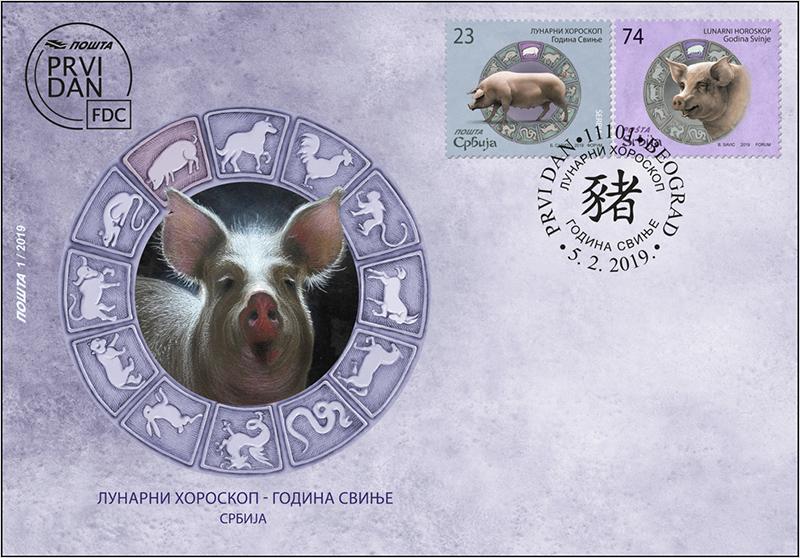

The lunar calendar is based on cycles of lunar phases, although most of the lunar calendars are actually lunisolar calendars. This means that the calendar months correspond to lunar cycles; however, intercalary months are occasionally added to harmonize these cycles with the solar year. Among these calendars are Chinese, Hebrew and Hindu calendars, as well as most calendar systems used in ancient times. Lunar calendars differ according to which day the month begins.
In the Chinese calendar, the first day is astronomically determined by the conjunction of the Sun and the Moon in the Chinese time zone.
Chinese Zodiac belongs to the oldest known astrological systems. It consists of 12 signs, each of which rules over one lunar year. These zodiac signs bear the names of animals (Rat, Ox, Tiger, Rabbit, Dragon, Snake, Horse, Goat, Monkey, Rooster, Dog and Pig). In addition to the basic signs, elements are also quite important in Chinese horoscope: wood, metal, water, fire and earth. Chinese astrology is based on the knowledge of ancient astronomers and the traditional Chinese calendar. It is also associated with ancient teachings about three harmonies – heaven, earth and water, Wu Xing teachings, Yin and Yang, five planets, 10 celestial streams and 12 earth branches, etc.
According to the lunar horoscope, 2019 is the year of the Pig and it begins on February 5th. Persons born under this zodiac sign are hard-working, compassionate and generous. They have excellent concentration abilities, and once they have set their goal, they will invest all of their energy to achieve it. They rarely seek help from other people, but are very willing to help. When faced with problems, Pigs will solve them carefully, no matter how big the problem was. Pigs have a very strong sense of responsibility, which makes them complete everything they start.
According to the lunar zodiac, 2019 will be the year of wealth and happiness. This year shall be full of joy, excellent for acquiring assets and investing, the year of friendship and love for all signs of the zodiac; it shall be a fertile year because the Pig attracts success in all spheres of life.
Artistic realization: MA Boban Savić, academic painter.
Easter
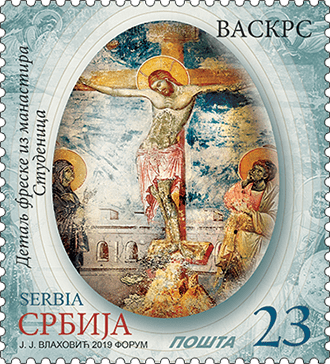



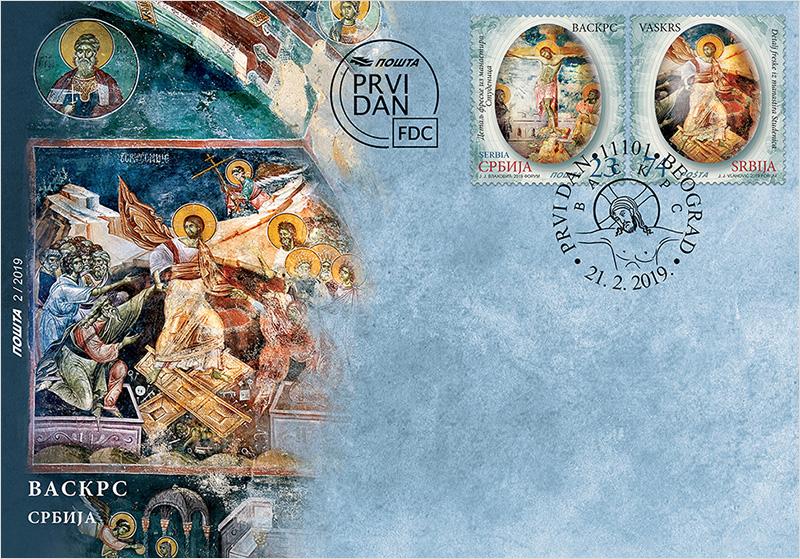

Easter Sunday is the date of the annual celebration of Christ’s resurrection. The date is not fixed, but denotes the same season of the year and the same relationship to the preceding astronomical full moon that occurred at the time of His resurrection in 30 A.D.
Easter is one of the most important Christian holidays. This is a day of eternal joy, the day when Christ, the Son of God, conquered the death. By the act of resurrection Jesus Christ proved his divine power and opened the gate of eternal life, joy and happiness that we can find in our faith.
On Easter Sunday morning the church bells toll, and the people, together with their priest, go around the church. After the third round they stand in front of the church door. The priest carries the cross, candle and the censer and chants the Easter hymn. The door open and they enter the church where liturgy continues. When it ends, people greet each other with the words: “The Christ has resurrected”, and “Indeed he has”.
There are many customs connected with Easter Sunday, and certainly one of them that children like best, is colouring and offering of eggs. The first egg is coloured red and in many parts of our country it is called “The house keeper” and is kept for the whole year, until the next Easter.
Motifs on the stamps and envelope: details from the frescoes of Studenica monastery.
Graphic realization of the stamps: MA Jakša Vlahović, academic graphic artist.
150 Years since the Birth of Mahatma Gandhi

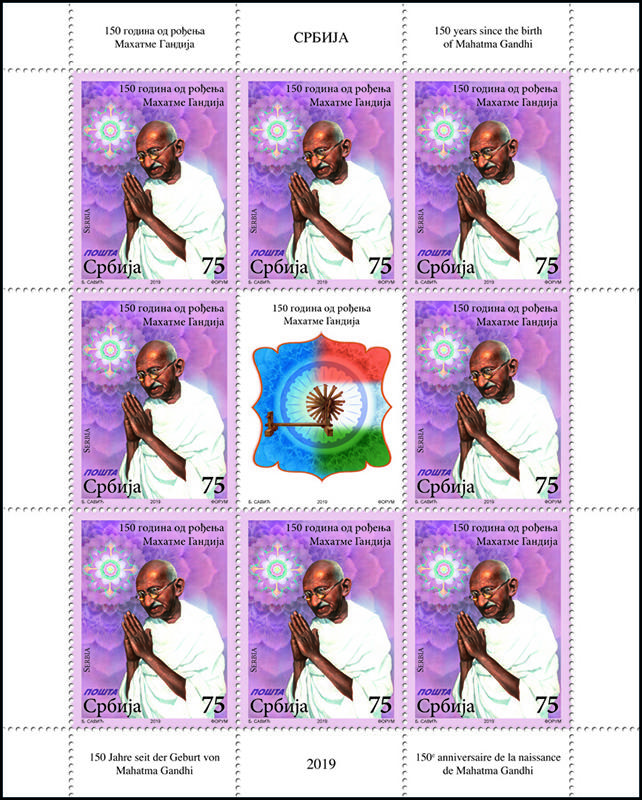
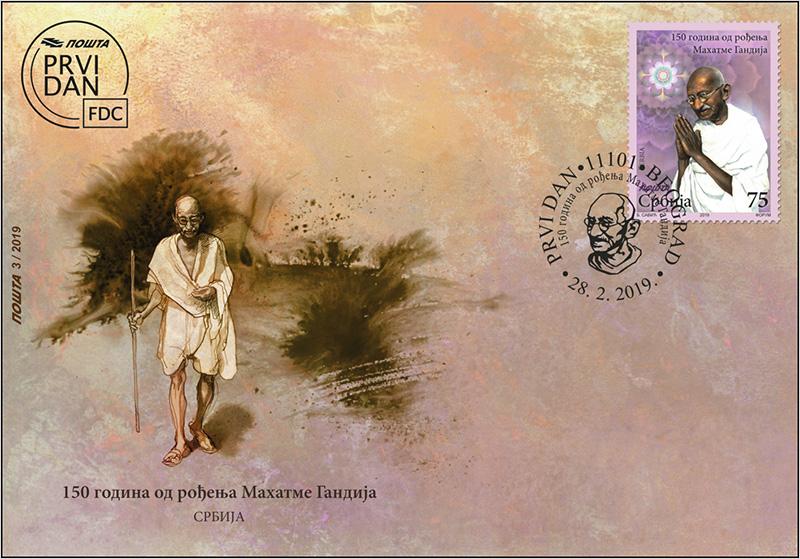

Mohandas Karamchand Gandhi (2 October 1869 – 30 January 1948) was the leader of the Indian independence movement. With his unusual, yet powerful political instruments of Satyagraha and non-violent protest, Mahatma Gandhi inspired political leaders and human rights and freedom movements all over the world.
Mahatma Gandhi was born in a wealthy Hindu family in Porbandar (Gujarat). Even in his childhood he was acquainted with the learning about tolerance, non-hurting other people and vegetarianism. He studied law at the University in Bombay and later in London. With his family, wife and children, he spent 20 years in South Africa as an employee at a branch of an Indian company, fighting against discrimination of the Indians in Africa.
As a founder of philosophy named Satyagraha – a resistance through mass, non-violent civil disobediance, he became one of the greatest political and spiritual leaders of his time.
His main goal was the fight for the independence of India which was a British colony at the time. He strived to reduce poverty, liberate women and eradicate discrimination, with the ultimate goal of India becoming an independent country. His efforts paid off when Great Britain finally declared Indian independence on 15 August 1947. Opponents of Indian independence murdered him on 30 January 1948.
The fight of Mahatma Gandhi for freedom and peace inspired human rights movements all around the world, and the United Nations established 2 October, Gandhi’s birthday, as the International Day of Non-Violence which, through education and raising of public conscience, helps spreading the message of non-violence and the wish to secure the culture of peace, tolerance and understanding.
Motif on the stamp: a portrait of Gandhi with symbolic display of the lotus flower in the background.
Motif on the vignette: charkha – a wheel for weaving cotton, a symbol of the passive resistance in India.
Artistic realization: MA Boban Savić, academic painter.
Flora








Fungi
Fungi are a diverse group of organisms that belongs to the particular empire of the living world, other than plants and animals. The science that studies them is called mycology. They often live in symbiosis with plants, they can be parasites or decompose the remains of organic matter.
During the course of more than a century of mycological research in Serbia, for the first time, a large number of previously unknown fungi species have been discovered here. The first example of the newly discovered species which is found by a certain researcher serves to describe this species scientifically. It is placed in the scientific collection at a museum or other scientific institution and it is called a HOLOTYPE. A larger number of holotypes of the species discovered in Serbia is kept at the National fungarium, the collection of mushrooms at the Natural History Museum in Belgrade. Almost the entire organized knowledge on distribution, diversity and interrelations in the living world, as well as the system of scientific nomenclature, are based on the studying of representative specimen of living beings, holotypes of plants, fungi and animals in collections and at museums. These collections are the foundation for further researches of some basic phenomena in the living world: evolution, ecology, influence of climatic changes, biogeography, animals’ behaviour, agricultural phenomena, and sociological and cultural phenomena.
Psilocybe serbica M. M. Moser & E. Horak M. M. Moser & E. Horak
Vojteh Lindnter, a curator of the Natural History Museum and a famous Austrian mycologist Meinhard Moser discovered this rare species in 1963 on Tara mountain, and later it was found in other European countries. The fungus is toxic and hallucinogen.
Tuber petrophilum Milenković, P. Jovan, Grebenc, Ivančević & Marković Milenković, P. Jovan, Grebenc, Ivančević & Marković
A rare species of truflles which was discovered in 2004 by Miroljub Milenković who later publicized his discovery with his associates. It grows in rock cracks which makes it unique among truflles. Up to this day, it was only found in Serbia, on Tara mountain.
Coprinopsis picacea (Bull.) Redhead, Vilgalys & Moncalvo (Bull.) Redhead, Vilgalys & Moncalvo
An unusual fungus from the group of Coprinus. Although it was first discovered in France in 18th century, it is important in Serbia because it can be seen on the emblem of the Mycologist society of Serbia, an expert society of mycoligists.
Octospora pannosa T. Richter, M. Vega & D. Savić
A tiny fungus, it parasitizes on moss Brachytheciastrum velutinum. It was found by Dragiša Savić in 2018 on Fruška Gora mountain. At the same time the same species was found in Germany, and the data were joined and then the discovery of the new species was formally announced.
Expert collaboration: Dr. Boris Ivančević, Natural history Museum in Belgrade.
Artistic realization of the stamps: Miroslav Nikolić
50 years of Radio Belgrade 202




Radio Belgrade 202, popularly called TwoOhTwo, is the youngest member of the Radio Belgrade family, the radio department of today’s public media service Radio-Television Serbia. It started broadcasting on the 27th of June 1969 and since then has been pushing the limits of the usual and traditional radio. It was and still is Serbian and regional innovator and champion in its direct communication with its audience as the first radio that implemented regular and direct participation of its listeners in voting – this spanned from voting for the best songs to voting for the best and worst celebrities and events in society.
This program, which has been living and breathing with its audience, is in touch with its listeners in the most various ways – from the newest forms of communication like social networks, through SMS services, e-mails, all the way to good old phone calls. This is the first radio that arranged live concerts. The audience and the listeners could vote for songs that were becoming weekly hits. Five decades people have been listening to the best Serbian and international pop and rock music, with special attention pointed to Serbian rock and pop music and supporting new, high quality artists. Thanks to TwoOhTwo, many singers and bands from Serbia and former Yugoslavia became huge regional stars. Some of the best artists, writers, actors, musicians, journalists, hosts, important people from all areas of expertise worked on this radio, and many extremely significant and famous people from Serbia and the world spoke for it. TwoOhTwo is directly or indirectly responsible for publishing many books and music albums. It is a radio that has been totally different from others for half a century now, an invisible friend who can entertain and make its listeners sing their hearts out, teach them something new and at the same time encourage them to think.
Expert collaboration: Editorial Board of Radio Belgrade 202.
Artistic realization: MA Boban Savić, academic painter.
100 Years of the Association of Drama Artists of Serbia




The foundation of the Association was initiated during the First World War, when the group of actors, having crossed Albania, created the theatre on Corfu and considered the foundation of their own class organization. The founding assembly of the Association of actors of the Serbs, Croats and Slovenians (the latter Kingdom of Yugoslavia) was held on 15 September 1919, and the Association of actors was the first to gather all the actors in Belgrade, at the time, but also all other theatre workers, with the aim to improve drama and artists’ status.
Funding of the Association was provided from the membership fee, through investments, gifts and different shares. With time, the pre–war Association initiated and realized significant shifts in the theatre business, and it acquired significant property (three multi-storey buildings in Belgrade and several building lots all around the country). It was acknowledged, respected and helped by the members, prominent individuals and the society. Archives record, among other things, the patronage of king Alexander I and his decoration with the order of St. Sava of the third grade.
In the years that followed after the Second World War, actors in Serbia were again organized with the same goal – to improve drama and protect professional interests of arts. The Association of Actors of Serbia (registered in 1950) estiblishes many of its activities on tradition and values of the pre–war class organization. It grants significant professional acknowledgements and awards, publishes theatre newspaper, books and other publications on actors and their creativity, supports members in individual artistic projects, helps socially and healthily threatened members, advocates the improvement of legal regulation which arranges the area of professional work of actors, etc. It is the bearer of the status of the representative association in culture and it performs entrusted operations of the confirmation of the status of an individual actor, expert and associate and regulating of their pension and health insurance.
Since the foundation of the Association until this day, the most significant artists from this region contributed to its development and afirmation.
Expert collaboration: The Association of Drama Artists of Serbia.
Artistic realization: MA Boban Savić, academic painter.
Doyens of Serbian Theatre




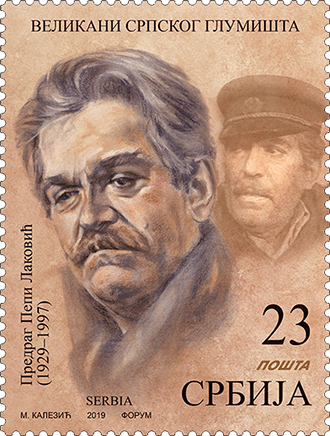









Velimir Živojinović, was born on 5 June 1933 in Jagodina. Together with Milena Dravić and Ljubiša Samardžić, he made a part of a trio of the most-loved film actors and one of the pillars on which Yugoslav and Serbian cinematography rested. He was nicknamed Bata by his sister, and his nickname become much more recognisable than his real name. He was also considered an actor being a real man of the people. He entered the world of art by peeping through the theatre window in which a rehearsal of a play was performed. As he used to say, he had no nerves to wait for Hamlet and he jumped into the film train. Bata Živojinović was somewhat of a lone ranger, a John Wayne of the Yugoslav partisan films. In his 57-year-long career, he acted in more than 350 films and TV series: I Even Met Happy Gypsies, Kozara, Birch, The Master and Margarita, Three, Balkan Express, Pretty Village, Pretty Flame, Let’s Go On... Owing to the film, he was privileged to have his morning coffee with Richard Burton and Elizabeth Taylor and make friends with Orson Welles. Due to his role in Walter Defends Sarajevo, he was a favourite actor of the hundreds of millions of viewers in China as well. As a man attached to his family, he refused the invitation from Hollywood. Bata was a founder and the first Chairman of the Serbian Film Actors Association. He died on 22 May 2016, taking his road to legend.
Ljubiša Samardžić, was born in Skopje on 19 November 1936. He was one of the greatest and the most award-winning actors of Serbian and Yugoslav cinematography. The nickname Smokie followed him since he acted in the same name film role. As a student of the Academy of Theatre, Film, Radio and Television, he won a scholarship for the Atelje 212 Theatre, however he permanently tied his career to film. He used to say that his favourite role was in the film Hamlet in Mrduša Donja, because his commitment and affiliation to film showed through this role. For his role in Morning, he received the prize Coppa Volpi at the Venice festival. His director's debut, was a film titled Sky Hook, followed by the films Nataša, Wasteland, Autumn Comes My Dear Quince, Black Stallions, Scent of Rain in the Balkans... He is the author of a testamentary, documentary, autobiographical film Panta Rhei. He acted in a number of cult films and series, such as: One Too Many, Battle on the Neretva, Savamala, Life is Beautiful, Death of Mister Goluža, Where Do the Wild Boars Go, Dimitrije Tucović, Love Life of Budimir Trajković, Policeman from Petlovo Brdo, Hot Wind… He died on 8 September 2017, bequeathing his many awards, diplomas and prizes to the Yugoslav Cinematheque.
Mira Stupica, was born on 17 August 1923, in Gnjilane. According to many, she is the greatest Serbian actress. Alongside Milena Dravić, she was declared the actress of the 20th century. With her husband and director, a leading figure Bojan Stupica, she built both the foundations and heights not only of the theatre life in the region, but also those of culture in the widest and most complete sense of the word. Cheerful, energetic, above all charming, charismatic... Her laughter, as people said, used to rend even the stars. Her talent, as well. And her wisdom. During her visit to Paris with the plays Dundo Maroje and Jegor Buličov, the hosts, seeing what kind of actress she was, gave her the clothes of Sarah Bernhardt, which were only accessed by the special ones. She played Petrunjela, Mirandolina, Baroness Castelli, Gloria, Nastasia Filipovna, Saša Negina, Grushenka, Madamme Saint Gene, Princess Xenia, the greatest characters of domestic and world classical and modern literature. She received all the significant theatre and movie awards and acknowledgements. She published the book of memoires A handful of salt, in 2000. She reclaimed from oblivion actress Žanka Stokić and, by establishing the award with her name, restored her at the scene of the National Theatre and to the collective memory, as well. She died on 19 August 2016.
A Montenegrin by origin, Slobodan Aligrudić was born on 15 October 1934 in Bitola. Had he not been an actor, he would have been a football player in Partizan. He was close to completion of the Academy of Theatre, Film, Radio and Television. In the sixties, Atelje 212 theatre where Mira Trailović had already gathered Zoran Radmilović, Slobodan Cica Perović, Petar Kralj, Bora Todorović, Bata Stojković, Milutin Butković and Vlada Popović, was only missing Alija to complete the octet of creators of the theatre’s good spirit, lasting even to this day. For his fastidiousness—as they used to say—in theatre affairs, he left Atelje and strode into the world of motion pictures giving his face and voice to characters in more than 90 films, television series and plays. The roles of antiheroes and complete characters in film noir were tailored to suit him: Dream, Ambush, Early Works, Once I am Dead and Pale, Love Case or the Tragedy of the Postal Clerk… The films Do You Remember Dolly Bell? and Father Is on a Business Trip directed by Emir Kusturica have marked his career. He died relatively young on 13 August 1985, being not even 51.
Predrag Laković was born in Skopje on 28 March 1929. He was famous for his nickname Peppie. He belongs to the generation of first post-war graduates of the course of acting at the Academy of Theatre, Film, Radio and Television in 1952. He started his career at the stage of the Belgrade Drama Theatre, just like the majority of his Academy peers, and performs on radio and television since the beginning of the Television Belgrade. Among other things, he mastered, with great authenticity, the roles of the little people from the margins of life, warm but unremarkable, melancholic loners and bohemians: barbers, shop owners, waiters, caretakers, train drivers, teachers now and then, journalists. He excelled in some of his most important roles at the stage of the Yugoslav Drama Theatre in plays: Sunset, Three Sisters, Croatian Faust, Battle of Kolubara, Deleted Road… He acted in more than a hundred of films and television series, among which: Bachelors, Tradesmen,Tradesmen, A Hanging Home, The Kharms Case, Life is Beautiful, Father Is on a Business Trip, The Minister’s Wife, Better Life… He is a laureate of the October Award of the City of Belgrade for his role in the film Magpie Strategy. He drowned in the Tisa river on 9 September 1997, whose banks gave him peace and refuge during his life.
Sonja Savić was born on 15 September 1961, in Čačak. She graduated in 1982, as the most talented actress of the generation 1977. She is one of the most talented, most beautiful and most special actresses of the Yugoslav and Serbian film. Her sensibility glittered in a special way on the movie tape. As someone noticed, Sonja was the last generation of artists who lived and died for ideals. She did not like classical theatres, she was attracted to alternative scenes. She built up and raised urban culture in the most beautiful manner. Vinyl skirt and jacket on naked body were not in fashion before her, she used to paint her nails black with Indian ink, because there was no black nail polish at the time. She was called the ’icon of rebellion’ in Ljubljana and she was impressed by it. She used to claim to be a part of punk generation, talented people who spoke what others think, but cannot say. Her career was also marked by the movies Una, To Live Like Normal People, The Decline of Rock ’n’ Roll, Sugar Water, Strangler vs. Strangler, Balkan Spy, We Are Not Angels... She received the Special Award in Venice for the role in the movie Life Is Beautiful. She died on 23 September 2008, young, at the age of 47.
Milorad Mandić was born on 3 May 1961, a Belgrader. He wanted to become a pilot, but he grew up rapidly and couldn’t fit into a plane! After the graduation, he became a memeber, leading actor, and later the director of the Boško Buha Theatre. He made his own name, surname and a nickname Manda. He started the renovation of the Theatre, fighting for the dignity of the profession and dignity of the youngest audience. His acting charisma was adorned by lavish gift for comedy. He emphasized that the theatre was ’’the last oasis of coherent thoughts, the place where precious experiences are acquired and memories are built, where knowledges, statements and emotions are exchanged.“ Among other things, he was a traffic policeman in the TV show On the other side of the rainbow and making the childhood of the 90s generations beautiful. He used to say: “Everything that happens to me is - fate, award and doom.“ He was not given the chance to take a bow for the last time, because he died on 15 June 2016, in the middle of the show Peter Pan, at the scene of the Buha theatre. Young, at the age of 55. The award for acting achievement in the field of comedy bears his name and it is given at the Niš festival of acting achievements in domestic cinematography Movie encounters.
Nebojša Glogovac, a Herzegovinian, was born in Trebinje on 30 August 1969. After graduation in 1994, he became a member of the Yugoslav Drama Theatre. A huge talent, reflectiveness, emotionality were his strength and driving force with which he filled his soul and the souls of others. Until the end of his life he devoutedly occupied himself with acting through which, as he said, he could better understand other people and life itself. With his acting creation he made a character he played alive, working, walking... He could capture the fullness of life and the essence as well, which he could transform into pure art. He accepted great applause as a returned emotion and thought. Dedicated, open, unburdened by fame, receptive... He was a Hamlet in his maturity, a Hamlet for antology and remembrance. He acted in the following movies and plays: Sky Hook, Huddersfield, Premeditated Murder, Powder Keg, Storm, Metamorphoses, Thunderbirds, Trap, Suspicious person, Constitution of the Republic of Croatia... His opus is a cultural asset. He received almost all major movie and theatre awards: Sterija Award, Tzar Constantine Award, Golden Arena, Miloš Žutić Award, Zoran Radmilović Award, Milivoje Živanović Award... and Dobrica’s Ring for Lifetime Achievement, posthumously. He died in Belgrade, on 9 february 2018, young, at the age of 49.
Expert collaboration: Association of Drama Artists of Serbia.
Artistic realization: MA Marina Kalezić, academic painter.
Cities of Serbia


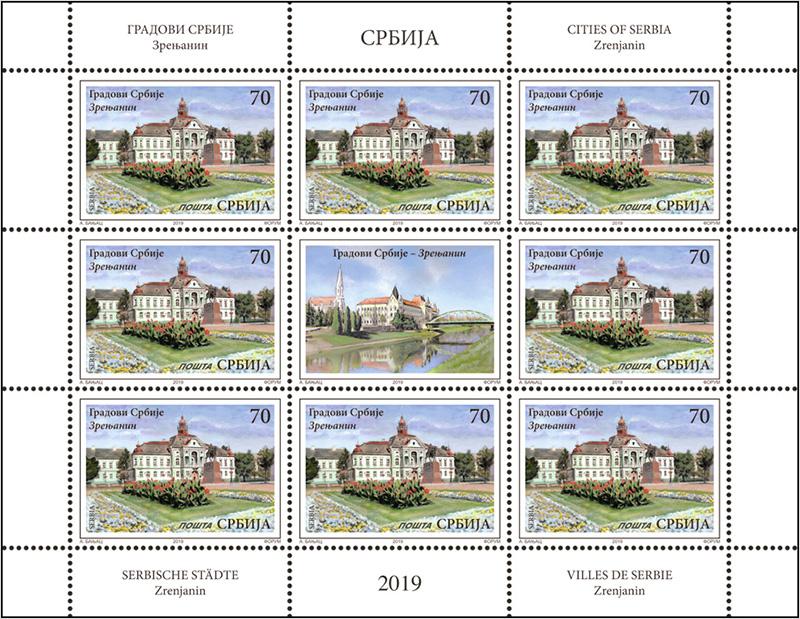

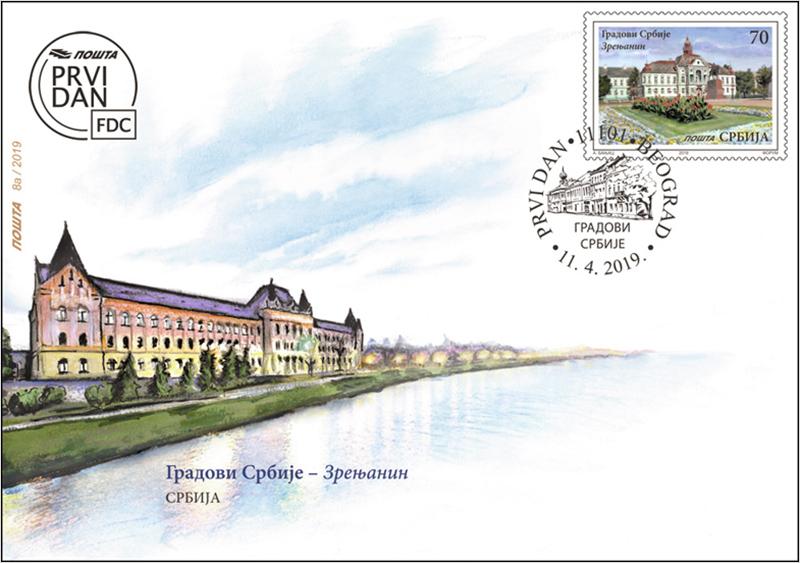

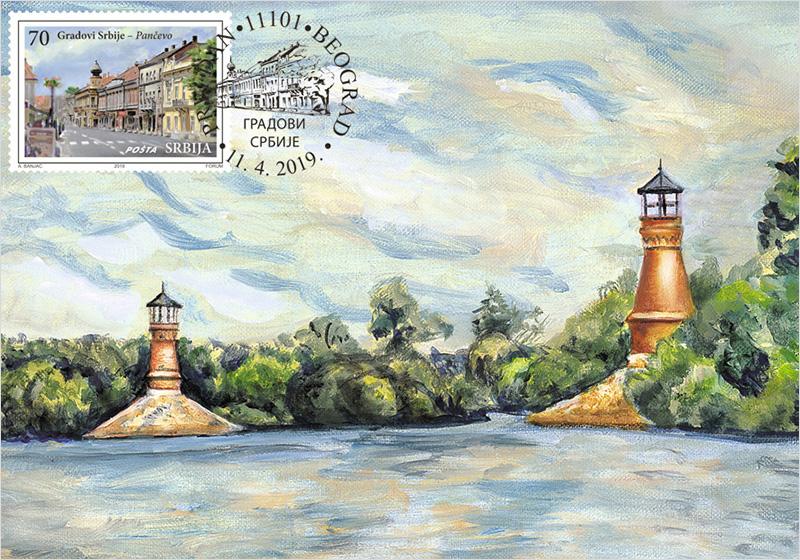
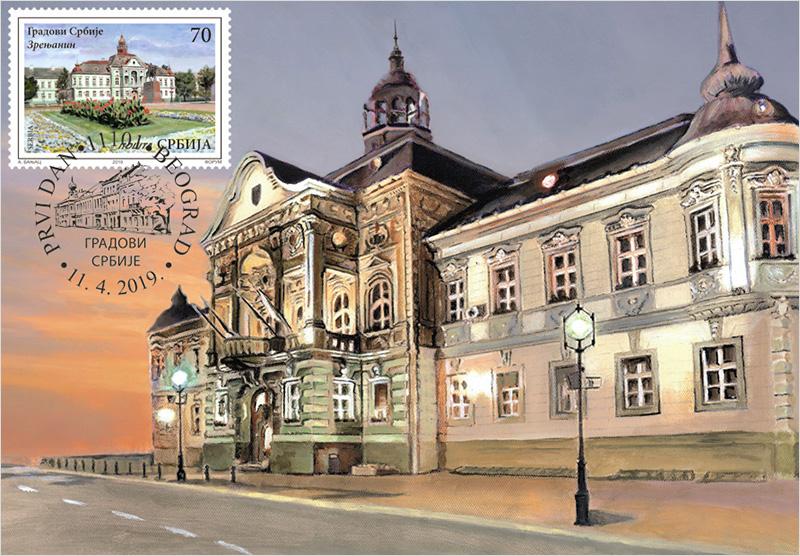

Zrenjanin
Zrenjanin is the largest city of the Serbian part of Banat and its political, economic, cultural and sports center. According to the territory size which administratively belongs to it (1326 km2), it is the largest in the Autonomous province of Vojvodina and the second largest in the Republic of Serbia. In the city itself and 22 other settlements live around 140 thousands of inhabitants and more than 20 nations. The city has been developing along with the tradition almost seven centuries long, because as a settlement under the name of Bečkerek it is mentioned in 1326 for the first time.
When you come to Zrenjanin today, you come to the city of multiculturality, international tolerance, and you also come to the city of culture, art, sport, the city of bridges, of the young and the city of the powerful economic momentum. Zrenjanin is recognized by the choirs of the world renomme, the National Museum or the Historic Archive, but also by sports names such as Dejan Bodiroga, Snežana Perić, Grbić brothers, Ivan Lenđer, Ivana Španović, and Maja Ognjenović. It can be recognized by the top quality shows of the puppet theatre, aquarrel art colony, culture events and traditional tourist and economic event ’’Days of Beer’’, which is held during the last week of August for over thirty years.
At the crossroads of important land and water ways, placed 50 km from Novi Sad, 75 km from Belgrade and 50 km from the European Union border (Romania), Zrenjanin is an open city today, ready to accept new ideas, ways of business thinking or development of new technologies. Zrenjanin is a city of traditional hospitality and possibilities for a pleasant holiday in its surroundings.
Stamp and Maximum card motif: City Hall, the former County Palace, built between 1817–1820 on the foundations of the Bečkerek Fortress.
Vignette motif: Small bridge with Court building. The Small bridge is the oldest bridge in the city, erected in 1904. Its surroundings make it the most interesting architectural whole of the old town core.
FDC motif: The Court building, a cultural monument of great importance, erected in the period 1906–1908 year, according to the project of architect Sandor Eigner.
Expert collaboration: Sanja Petrović, Assistant Director of TO of City of Zrenjanin. Artistic realization: MA Anamari Banjac, academic painter.
Pančevo
The city of Pančevo is located in the Southern Banat and is bounded by the Danube and Tamiš Rivers. Owing to its position, it attracted people to settle here from ancient times, but many conquerors as well: from mediaeval times the Serbian, Hungarian, Turkish and Austrian rulers took their turns. Rich cultural and industrial heritage, multicultural spirit of the city and closeness to Belgrade as the capital city, make Pančevo almost ideal for living.
From times immemorial, Pančevo has been known as a commercial and craftsmen’s town, from which the top-quality silk, wheat, salt, famous Weifert beer and various artisan products travelled by steamboat to Europe. Closeness to the Deliblato Sands and its wavy edges, as well as the Old Town, have always attracted film crews, and Pančevo was the host to many big stars of both Yugoslav and world cinematography, who in the town on Tamiš made more than one hundred films.Among the famous artists, scientists and researchers who lived and worked in Pančevo were Mihailo Pupin, Jovan Jovanović Zmaj, Đorđe Weifert, Isidora Sekulić, Dr Vladimir Aleksić, Dušan Bošković, archpriest Vasa Živković, Uroš Predić, Stevan Aleksić, Ilija Kolarac, Jovan Pavlović, brothers Kamenko and Pavle Jovanović, Dr Mihovil Tomandl, Dr Svetislav Kasapinović, Milan Ćurčin, Miloš Crnjanski, Miroslav Antić, and many others.
“Folk Garden” city park, Vojlovica Monastery, Church of Transfiguration, Church of Assumption of the Mother of God, Evangelistic Church, Roman Catholic Church of Saint Charles Borromeo, Lighthouse on the confluence of Tamiš into the Danube, Red Warehouse, are some of the symbols of Pančevo
Stamp motif: city centre, Vojvoda Radomir Putnik Street.FDC and vignette motif: Church of Assumption of the Mother of God, known to the Pančevo citizens as the Two-Tower Church built in 1811. The two towers symbolised the Serbian people in two empires – Turkish and Austrian.
Maximum card motif: Lighthouses on the confluence of Tamiš into Danube, built in 1909. Today they are the only two lighthouses left on the entire flow of the Danube.
Expert collaboration: Dr Živana Krejić, Docent, and “Visit Pančevo” Association. Artistic realization: MA Anamari Banjac, academic painter.
Protected animal species





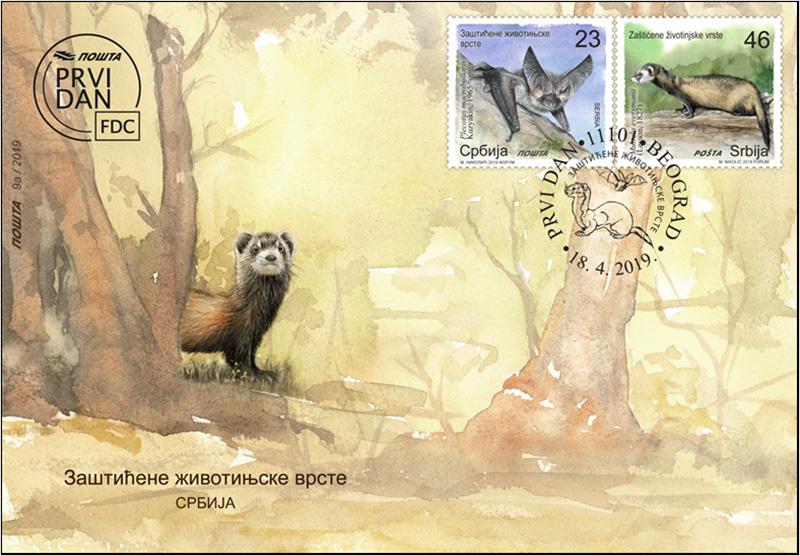


Alpine long-eared bat Plecotus macrobullaris Kuzyakin, 1965
It lives in higher mountain areas of Serbia. It uses caves and other underground objects as shelters. It hunts twilight and nocturnal insects in the forested habitats. In Serbia, it was discovered for the first time in July 2013, in a cave in Ćetanica mountain in the municipality of Prijepolje. It is considered to be connected to the areas where limestone formations dominate with numerous underground karst objects. Therefore, it is realistic to expect to find it in the mountains in karst areas of western and eastern Serbia. Reproduction in Serbia is not proved, although it is highly likely.
According to the criteria of the IUCN (International Union for Conservation of Nature), the Alpine long-eared bat is classified into category of near threatened species (NT) on European and Mediterranean level. In Serbia, where the species was found recently, it is classified into the species for which the data for evaluation of their status of threat are missing.
Steppe polecat Mustela eversmanii (Lesson, 1827)
The largest of all European polecats. Its body is spindle-shaped and flexible, with short legs and a long, ornate tail. Its fur is light yellowish with long brown hairs, and its legs and tail are dark brown. Its ears are short, and it has a typical mask on the head. It lives in Asia, eastern and central Europe, and in Serbia it lives in Vojvodina and northern parts of central Serbia, most commonly near still and slow flowing waters. It feeds on tiny field rodents such as common voles, hamsters and European ground squirrel, but it gladly feeds on birds, frogs and lizards. A female gives birth up to 8 young which are born in April, blind and furless. Its enemies are foxes, jackals and stray dogs. However, it is mostly threatened by persecution by humans, destroying steppe habitats and by using rodenticides in agriculture. Due to its close relation to the European polecat (Mustela putorius), hybrid specimen can be found in the wild.
According to the IUCN criteria, Steppe polecat is not an threatened species, but the population in eastern Europe is threatened due to, above all, disappearing of steppe habitats, as well as in Serbia where it is classified as strictly protected wild species and where a special project of revision and determination of condition and status of populations is realized.
Expert cooperation: Dr. Milan Paunović, senior curator, Natural History Museum in Belgrade Artistic realization of the stamps: Miroslav Nikolić.
Balkan Chamois Rupicapra rupicapra balcanica Bolkay, 1925
A strong and ellegant hoofed animal of a thin neck, small head and slender firm legs, it lives at 500 up to 3100 m above sea level. Its habitats are rocky gorges, canyons and mountain rocky grounds above upper forest line. The range of Balkan chamois is of insular type. In Serbia, this species lives autochthonously in the Drina river canyon, in Mokra Gora, Prokletije, Koritnik and Sharr Mountains. Furthermore, the introduction was successful at two localities in eastern Serbia - in the Đerdap (Iron Gate) gorge and in the Lazareva Klisura gorge near Zlot in Bor municipa-lity. Chamois live in smaller herds. They have excelent vision and hearing. They mate from November until January, when males gather two to six females into their harem. The young are born in April. They lifespan is 10 years in the wild, and up to 18 years in captivity. The number of chamois in Serbia is slightly increasing.
According to the IUCN (International Union for Conservation of Nature) criteria, chamois is not an threatened species. In Europe they are threatened due to disappearing of habitats and due to small number and isolation of local populations which result in inbreeding. In Serbia, it is classified into protected wild species, but also hunting species protected by close season.
Brown bear Ursus arctos Linnaeus, 1758
It is the largest European terrestrial mammal. Its body is squatty and sturdy with a massive head and long snout. Its legs are strong, with big claws. The tail is short. The fur is rich, and hairs thick and long. The colour of the fur varies from light brown to dark brown. It lifespan is relatively long in the wild, from 20 to 30 years. It is omnivore and it lives solitary except in the period of mating and when a female raises the young. It is a polygamous species. It mates from the middle of May until July. Female has a delayed embryo development and it gives birth up to three young during winter, while still hibernating. The young are blind at birth, furless and toothless and they weigh up to 500 grams. A female breastfeeds cubs until the beginning of summer and they leave their mother only at the age of two or three.The brown bear is the most widespread bear species, although today it is present only in the part of its former range. Serbia is the only country which has on its territory three European populations of bears - the Dinara-Pindos, Carpathian and East-Balkan population. The number of bears in Serbia is slowly increasing.
According to the IUCN criteria, the brown bear is a threatened species, although globally and in Europe it is not. In Serbia, it is classified into strictly protected wild species and permanently protected hunting species.
Expert cooperation: Dr. Milan Paunović, senior curator, Natural History Museum in Belgrade
Artistic realization of the stamps: Miroslav Nikolić
Artistic dance in Serbia









Maga Magazinović (1882–1968), was one of the most educated women in Serbia at the start of 20th century, a pioneer of artistic dance, but also on the battlefield of women’s equality. She graduated from the Faculty of Philosophy as the first female candidate in her group. She also enrolled at the Faculty of Law so as to open the door to female students into the up-till-then exclusively male domain of law studies. As the first female clerk in the National Library, in 1905 she worked as a trainee and the first journalist who published articles for Politika daily (1905/1906). Artistic, dancing and theatrical knowledge she acquired with the most prominent theatre names of her time in Germany: Max Reinhardt, Émile Jaques-Dalcroze, Rudolf von Laban, Isadora Duncan. As the first educated dancer, she opened a school of modern dancing (1910), at the time when in Serbia the classical ballet had not yet existed. In 1936, she founded the Student Folklore Group; she greatly contributed to spreading of dancing skills, the new understanding of female body and gradual reducing of aloofness towards women in various domains of professional creation. She is one of the progenitors of choreodrama in our country. She is the author of the first professional literature and texts on dancing in Serbia. She died on 8th February 1968.
Smiljana Mandukić (1907–1992), was the progenitor of modern dancing in Serbia and the region. She acquired her dancing expertise in Vienna where she made first successes on stage as a solo dancer. She learned from famous Viennese artists: Gertrud Bodenwieser and Grete Wiesenthal.
In the interwar period, she performed in Belgrade, where in 1931 she founded a modern dance school. She even held her dancing classes on the Radio Belgrade waves from 1931 till 1940. She was one of the procreators of choreodrama as a specific theatre genre in our region. She also established the first professional troupe for modern dance by which she affirmed the alternative dancing movement.
She was an instructor of Rhythmic and Stage Movement from 1941 till 1946 at the Academy of Music, and also a professor teaching Stage Movement at the Higher School of Film from 1947 till 1950. She took part in the founding of the City Ballet School in Belgrade and was its main teacher. She engaged in choreographic and educational work at the Cultural and Artistic Association “Abrašević” and in the professional dancing troupe “The Belgrade Modern Ballet of Smiljana Mandukić”, which she founded in the seventies. She died on 12th May 1992. The Ballet Artists Association of Serbia established in 2012 an award named after Smiljana Mandukić, a pioneer of modern dance in Serbia.
Jovanka Bjegojević (1931–2015), was a prima ballerina of the National Theatre in Belgrade who earned world-wide recognition. She performed in a tremendous number of impressive roles and had a reputation of an excelling artist who, in her interpretations, brought about a unity of spiritual, emotional and bodily expression. She danced with great success in France as a member of troupe of the famous Jean Babilée; she danced in the National Ballet of Australia as a prima ballerina in famous ballets, such as Swan Lake, La Sylphide, Giselle, The Sleeping Beauty… Enriko Josif composed specially for her the famous Serbian ballet Bird, Don’t Fold Your Wings. At the Faculty of Drama Arts in Belgrade, she introduced the course of Stage Dance at the Department of Acting, where the prospective actors learn the basics of classic dance and culture of movement. In addition to being prima ballerina and her performances in the classic repertoire, she gave an enormous contribution to contemporary artistic dance. As a pedagogue, she contributed to the development of the Serbian dancing community and participated in the establishment of the Association of Ballet Artists of Serbia in 1962. She was the Director of the Ballet of the National Theatre in Belgrade. She was a laureate of the Seventh of July Award in 1962 and of the Lifetime Achievement Award bestowed by the Association of Ballet Artists of Serbia in 1998. She died on 30th August 2015.
Dušanka Sifnios (1933–2016), prima ballerina of the National Theatre in Belgrade, world-renowned ballet star, soloist in the famous troupe of Maurice Béjart – Ballet of the XX century. After the Ballet School in Belgrade, which she finished in the class of a famous Russian ballerina, Nina Kirsanova, she entered the Ballet Company of the National Theatre in Belgrade, where she had, while still a student, already played solo roles in the Swan Lake. As a prima ballerina of the Belgrade Ballet Company, with extraordinary performances in Orpheus, La Sylphide, Romeo and Juliet, Giselle, Coppélia, she remains unsurpassable for the fantastic performance of the role of the Girl in the The Miraculous Mandarin, to the music of Béla Bartók and the choreography of Dimitrije Parlić. She cooperated with world-renowned choreographers Léonide Massine and Milorad Mišković in Italy and France, but will always be remembered for playing in Maurice Béjart’s ballet troupe: Ballet of the XX Century. The famous Béjart, inspired by her, created the legendary historical ballet Bolero, to the music of Maurice Ravel. Dušanka Sifnios also made a film version of Bolero for Bavarian television, as well as The Fantastic Toyshop, The Blue Danube, etc. She won the Lifetime Achievement Award of the Association of Ballet Artists of Serbia in 1998. Dušanka Sifnios died on 14th October 2016.
Expert collaboration: Vera Obradović, PhD (Professor) and Svenka Savić, PhD (Professor Emerita); Belgrade City Museum and Association of Ballet Artists of Serbia.
Artistic realization: MA Nadežda Skočajić, academic graphic artist.
Europa – national birds

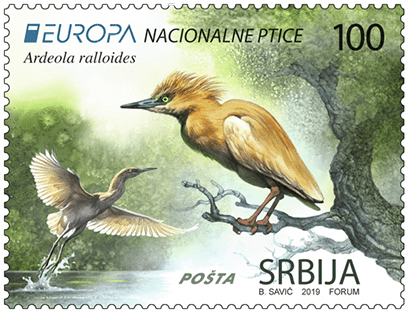
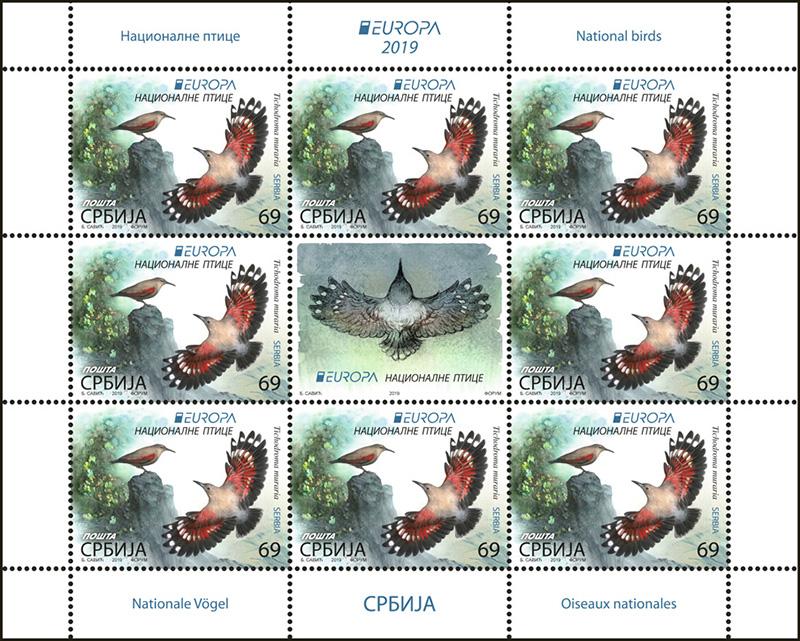

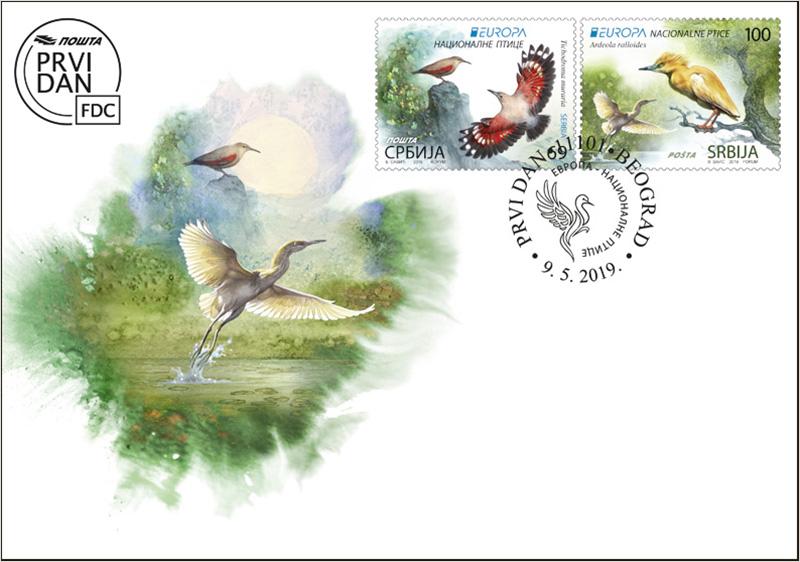

Out of more than 350 bird species recorded at Serbian territory, 240 breed permanently in our country.
Tichodroma muraria – Wallcreeper
The Wallcreeper is a passerine bird which inhabits high mountains, between 1,000 and 3,000 m above sea level, from Southern and Central Europe to China. This little bird, weighing around 17 gr, has blue–grey feathers with dark flying and tail feathers. However, the most impressive feature of the Wallcreeper is bright red colour on its wings, which is especially noticeable when the bird flies.
Although it is sedentary bird, some vertical migrations were marked during the cold winter months, towards lower altitudes. Female builds nest of grass and moss in the cervices of rock cracks or in holes. A typical nest has two holes. Female lays 4–5 eggs in the nest, during May and June, depending of the breeding altitude. During incubation only a female lies on the eggs, while a male feeds her all the time. Both parents take care of the nestlings. The Wallcreeper is an insectivore – it feeds on insects, spiders and invertebrates which collects from the rock surfaces.
According to the IUCN (International Union for Conservation of Nature) criteria, the Wallcreeper is not globally endangered species. The population in Serbia is stable. The main nesting sites are at the mountains of the Eastern and Western Serbia.
Daliborka Stanković, PhD, Senior curator ornithologist, Natural History Museum in Belgrade.
Ardeola ralloides – Squacco Heron
The Squacco Heron is a small species of heron. It has a short neck, a short, big beak and brown back. It reaches 44–47 cm in length, with wingspan of 80–92 cm. In the summer, grownups have long feathers on the neck. Its look is changed during flying when, thanks to the colour of its wings, it looks like it was white. Heron’s colours are wonderful, especially nuptial plumage.
The Squacco Heron is nesting bird of the Special Nature Reserve “Gornje Podunavlje”, in the north of Serbia – the left bank of the Danube river from the Hungarian border to the bridge at Bogojevo. It nests in mixed colonies with other heron species. It arrives to our regions at the end of April, and it migrate to warmer regions at the end of August. It nests in thick reed bads, with single willows and osiers. It feeds on fish, frogs and various insects. The number of the hatchlings ones 3–5.
According to the IUCN criteria, Squacco Heron is – endangered species, and it is strictly protected.
Jovan J. Lakatoš, an ornithologist and nature photographer.
Artistic realization: MA Boban Savić, academic painter.
Museum Exibits




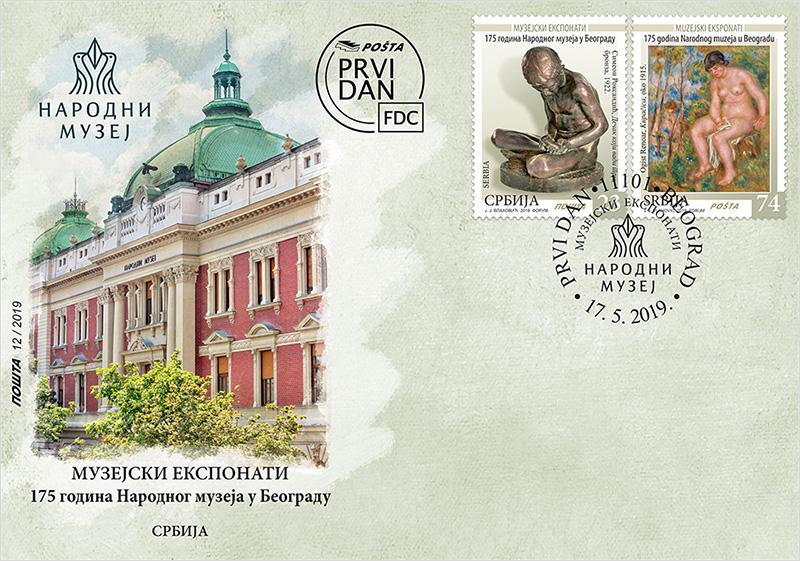



175 years of the National Museum in Belgrade
The National Museum in Belgrade is the oldest and central museum of Serbia. Today, after 175 years since the foundation, it conserves, studies and exhibits more than 450,000 of museum items which represent a unique whole of the cultural heritage of Serbia, Central Balkan, as well as Europe.
Its central building being placed in the very centre of Belgrade in the Republic Square, the National Museum conserves representative cultural goods, testimonies of development and civilization changes in the territory of today’s Serbia and the closest surroundings, from the prehistoric times until the late Medieval period, as well as the representative works of the key artistic styles and movements, superior artistic ranges in the national and European art from the Medieval period until the modern time creativity. Lepenski Vir is especially worth mentioning (VII millenium B.C.), Vinča sculptures (VI–V millenium B.C.), Dupljajska kolica (XVI–XIII century B.C.), golden masks from Trebenište (VI century B.C.), pantry from Jabučje (I century), Belgrade cameo (IV century), Miroslav Gospel (XII century), money of king Radoslav (XIII century), medieval icons and frescos, bowl from Vraćevšnica (XVII century), paintings of Paja Jovanović, Nadežda Petrović and Sava Šumanović, the works of the old Italian masters (Di Credi, Canaletto, Guardi), of the Dutch art (works of the ateliers of Bosch, Brueghel, Van Goyen and Rubens, as well as some works of Toorop, Van Gogh and Mondrian). The National Museum conserves the works of the French art from the late XIX and the beginning of the XX century (Corot, Daumier, Pissarro, Renoir, Degas, Sisley, Gauguin), and the story of modern art is rounded by the works of Picasso, Kandinsky, Archipenko and Chagall. These extraordinary museum exhibits arrived in the National Museum mostly by researches, repurchases or gifts by benefactors, which were numerous in the long and rich history of this museum among rulers and even more among citizens. All of them contributed to the National Museum in terms of its becoming the true symbol of the Serbian culture.
Motifs on stamps: 23 RSD – Simeon Roksandić, The Boy Plucking the Thorn, bronze, 1922; vignette – Blacksmith, end of VIII – beginning of VII century B.C, bronze, Vranište. 74 RSD – Auguste Renoir, Bather, around 1915; vignette – Milan Milovanović, The Blue Door, 1917.
Expert collaboration: National Museum in Belgrade.
Graphic realization of the stamps: MA Jakša Vlahović, academic graphic artist.
800 Years of Autocephaly of the Serbian Church
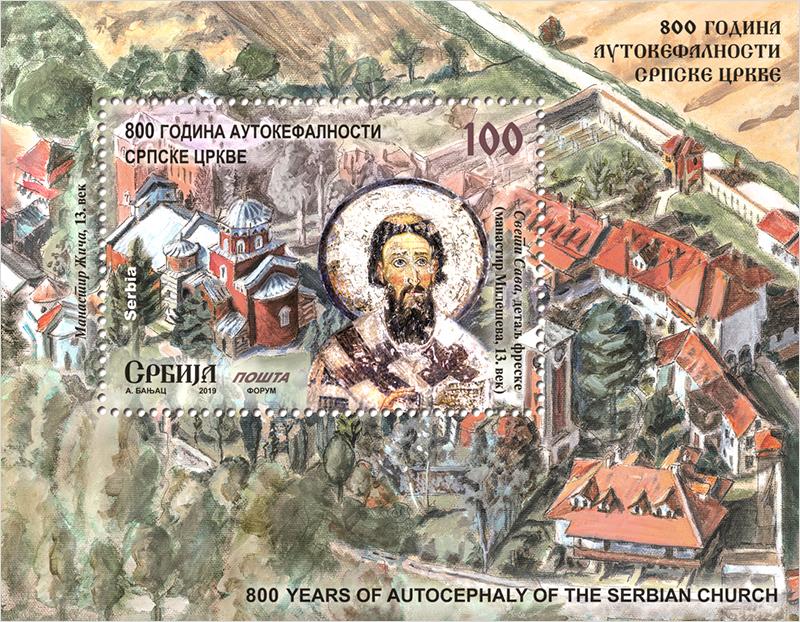


Rastko Nemanjić – named Sava in monasticism, the youngest son of the great zhupan of all Serbian countries Stefan Nemanja, had a crucial role in acquiring autocephaly of the Serbian Orthodox Church. Leaving the administration of the Hum Region, around 1191, he became a monk in Mount Athos, where he welcomed his father, who was at the time already monk Simeon. After they restored the neglected monastery of Hilandarion, further development of the Serbian church issue was heralded. After Simeon’s death in Hilandarion (1199), Sava returned to Serbia with his father’s relics to Studenica monastery – the place of rest of the saint, to reconcile his quarreling brothers. In Mount Athos and Studenica, where he was the abbot from 1206 until 1217, Sava devoutly worked on laying the foundations of the Serbian Church by establishing monasteries, writing Typikons, arranging the order of monastic and divine service life, as well as translating and codification of the rich written Byzantine ecclesiastic and legal heritage.
The Serbian Church became completely independent only after Sava’s recognition as the first Archbishop of all Serbian and maritime lands by the good will of the Byzantine tzar Theodore I Laskaris and by the blessing of patriarch Manojlo Haritopul Saranten in 1219 in Nicaea. This event represents the milestone in the history of the Serbian people of crucial importance for further education, organization of society and building of cultural and spiritual life of the Serbs.
Acquiring the right to independently consecrate archbishops and clergy, under Sava’s administration, the Church established new dioceses. In the Žiča monastery, the seat of the archdiocese, Sava coronated his brother Stefan the First-Crowned to become the king and consecrated bishops of Hum, Zeta, Hvosno, Budimlje, Dabar, Moravica, Toplica, raška, Prizren and Lipljan. With The Nomocanon of Saint Sava, the first legal code of the Serbian Church and supreme state law, written around 1220, Serbia became legal state governed by the principle of consent between secular and spiritual authority.
Motif on the block: Žiča monastery and St. Sava, detail оf the fresco from Mileševa monastery
Artistic realisation: Anamari Banjac, academic painter
Expert collaboration: Miljana Matić, PhD, curator and deacon Aleksandar Sekulić,
Serbian Orthodox Church Museum in Belgrade
Science


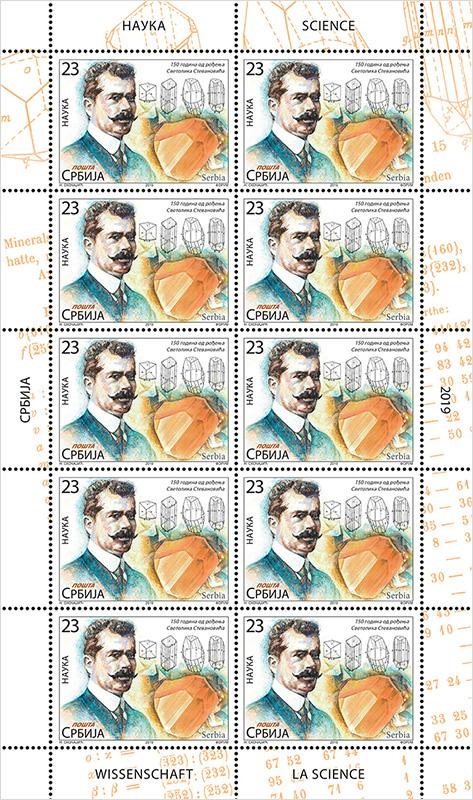




150 years of the birth of Svetolik Stevanović
Svetolik P. Stevanović (Majdan at Rudnik Mts. 5. 3. 1869 – Belgrade, 10. 5. 1953) belongs to the first generation of Serbian geologists with specialization on mineralogy and crystallography. After his elementary school education in his birthplace, he continues education in grammar school in Gornji Milanovac, Čačak and Kragujevac (finshed in 1889). Four years later, Stevanović graduated at the Department of Sciences, Faculty of Philosophy of Velika Škola in Belgrade. Later he had worked as a professor supplent / demonstrator at Velika Škola and continued five semester long doctoral studies of crystallography and mineralogy in Munich, where he defended his doctorate during 1902.After return to Serbia, Stevanović works as a teacher of German in Jagodina as well as at First Grammar School of Belgrade. He took part in the Balcan wars and WWI, from 1912 untill 1918 as a solder of the Serbian Army. Stavanović was promoted to lieutenant colonel and sent to Beaulieu-sur-Mer near Nice, to be headmaster of the Serbian Grammar School. From 1922 till his retirement in 1924 he works as a lecturer of geology and mineralogy at Faculty of Agriculture, University of Belgrade and at Pedagogical High School in Belgrade beside as a Vice-Ministry of Education.Stevanović first applied the crystallographic methods for the mineral analysis in Serbia. He was adored to sciences beside that his jobs were not scientific. He has the successful studies of minerals and mineral waters. He published 36 papers related to the mineralogy and crystallography. His geological studies of Niška Banja and Vrnjačka Banja were published in two monographs.
Motif on stamp: portrait of Svetolik Stevanović with Auripigment mineral.
Expert collaboration: Dr Tivadar Gaudenyi, Serbian Geological Society – History of Geology Division.
150 years of the birth of Jelenko Mihailović
elenko M. Mihailović (Vrbica near Knjaževac, 11. 1. 1869 – Belgrade, 30. 10. 1956), Serbian naturalist, considered as one of the founders of the Serbian seismology. Founder of the Seismological Institute in Belgrade and recognized as a great promoter of science. In the period from 1893–1906 Mihailović graduated as a student of Velika Škola in Belgrade and continued work in the very same institution as the assistant of Milan Nedeljković (the founder of Belgrade astronomical observatory). From 1901 he carried the macroseismic measurements, while from 1904 was responsible for microseismic measurements. From 1906 he organized the seismological survey at Geological Institute, University of Belgrade (the seismological measurements moved in 1901 to the observatory). Thankfully to Mihailović the Geological Institute got its seismological station in Tašmajdanski park, and he was its director from 1919 until his death in 1959.
After his university graduation followed the specialization studies abroad (in Strasbourg, Paris and Berlin), then work on the establishing of the seismological survey of SHS Kingdom. At the Association Internationale de Séismologie Jelenko M. Mihailović was the national representative, and beside it he was also member of Italian Seismological Society and the Spanish Astronomical Society.
From 1906 till 1939 he was a professor of seismology at Faculty of Philosophy and Faculty of Agriculture, University of Belgrade. In 1932 Mihailović was appointed for the Rector of Pedagogical High School in Belgrade. He published 195 scientific studies/papers and some textbooks (mainly of physics). His research focus was quite wide, from regional geology, paleontology, astronomy, klimatology, mathematics, physics and seismology. He was decorated with St. Sava Medal of 3rd and 4th level for pedagogical work, Albanian Memorial and Silver Medal for contribution in wars 1912–1918, and the Diploma of the Serbian Geological Society for his scientific work.
Motif on stamp: portrait of Jelenko Mihailović with Mainka Seismograph.
Expert collaboration: Dr Tivadar Gaudenyi, Serbian Geological Society – History of Geology Division and Branko Dragičević, deputy director of Seismological Survey of Serbia.
Artistic realisation of the stamps: Nadežda Skočajić, academic graphic artist.
Ljubičevo Equestrian Games




In the immediate vicinity of Požarevac, on the right bank of the Great Morava, Prince Miloš Obrenović built a summer house for his wife and children in 1858. In addition to the facility, he built several stables where he held his horses, perhaps the only private horses in Serbia in Turkish times. Prince Miloš donated this estate, called Morava, and all the horses on it, in 1860, to the state. The horse farm which was the second largest in Serbia at the time was a part of the Horse breeding Institute Dobričevo near Ćuprija. The management of the Institute was later moved to Požarevac, and then to the Miloš estate Morava, which Prince Mihailo Obrenović named Ljubičevo in honor of his mother Ljubica.
At the beginning of the 20th century, Ljubičevo was a horse-breeding institution of the European rank, with about 500 heads of pure breed, studs from Constantinople and fillies from Austria. Over the decades, the horse farm survived numerous misfortunes of national history, but a revival always came after a tough period. On several occasions it suffered devastation, and in 1965 it was restored at the initiative of the equestrian club Veljko Dugošević.
The restoration of the horse farm was also encouraged by holding of Ljubičevo Equestrian Games, an international sports and tourist event created in 1964, as a reflection of the tradition of the people of the Stig and the Pomoravlje region, and its eternal love for the noble animal – the horse. The beginning of Ljubičevo Equestrian Games is marked by the parade of the participants. Before the parade, previous Knight of the Ljubičevo eventing hands over the saber to the mayor of the City of Požarevac, who after the end of the Games hands it over to the new winner of the Ljubičevo eventing.
In addition to gallop and harness racing, endurance riding, equitation competition, children’s equestrian voltige, horse show and horse cart race, this event also has a unique competition in the world – Ljubičevo eventing. In this competition, brave knights on horses compete in five traditional disciplines: mace shooting, arrow shooting, spear shooting, saber cutting and courier riding. The winner is entitled the Knight of Ljubičevo, and receives the red knight’s cape and the saber.
This year, the 56th Ljubičevo Equestrian Games are held on 30th, 31st August and 1st of September.
Expert collaboration: Sandra Šarčević, Graduated Geographer-Tourismmologist, Tourist Orga-nization of the City of Požarevac and Vasilije Baldić, B. Sc. engineer of management, Acting Director of Tourist Organization of the City of Požarevac.
Artistic realization of the stamp: MA Boban Savić, academic painter.
European nature protection






Special Nature Reserve “Rtanj”
Rtanj covers an area of almost 5,000 hectares with exceptional geological, geomorphological, biological, historical and aesthetic values, and rocks of different ages from the Palaeozoic, Mesozoic and Cenozoic periods. Of particular value is the relief with the pointed peak “Šiljak”. It is a habitat for strictly protected species of Serbian flora – Ramonda serbica, Rtanj mint, Orchis, Orchis coriophora, Paeonia mascula, Alpine clematis, Pulsatilla alpina, Gentiana acaulis, Gentiana kochiana. It is also the habitat for the extremely rare and endemic species of Nepeta rtanjensis, and among medicinal species, Rtanj tea particularly stands out. There are 89 bird species at Rtanj, and 20 registered species of bats that account for 2/3 of the total number of bats in Serbia. There are as well indigenous fish species in the streams of the foothills of the Rtanj Mountain (Brown Trout, Mediterranean Barbel, Gobio Gobio, etc.), while completely isolated populations of interesting species in terms of evolutionary changes are recorded in Vrmdža Lake. Based on the Study of Protection, conducted by the Institute for Nature Conservation of Serbia, the Special Nature Reserve “Rtanj” was declared a protected area of the first category of international, national, and exceptional importance.
Danko Jović, Msc; Institute for Nature Conservation of Serbia
Monument of Nature “Borač Karst”
“Borač Karst” covers an area of 68,22 hectares and represents the remnants of the lava dome, formed by the swelling of the thick masses of acid lava, parts of which have been eroded over time, thus creating a distinctive appearance of the area. Together with the Gruža Lake, it forms the IBA area (Important Bird Area). There are 79 bird species recorded at the very Karst – 21,9% of the total bird diversity in Serbia, primarily predators – 11 species (Honey Buzzard, Common Buzzard, etc.), nocturnal predators (Eagle Owl, Tawny Owl, Long–Eared Owl, etc.) and dozens of passerines of the area (Woodlark, Cirl Bunting, etc.). During the Middle Ages, the “Borač Karst” was an important fortification and on it there used to be the town of Borač. The remains of the former fortification, with the Church of the Holy Archangel Gabriel and the old cemetery at the foot of the Karst, represent the architectural and petrological objects of Serbia’s geological heritage, since they were built of stone from the “Borač Karst”. Based on the Study of Protection, conducted by the Institute for Nature Conservation of Serbia, the Monument of Nature “Borač Karst” was declared a protected area of the first category of international, national, and exceptional importance.
Mirjana Nikolić, Geology Eng.; Institute for Nature Conservation of Serbia
Artistic realization of the stamps: Miroslav Nikolić
Tourism in Serbia





Sokobanja
Feel the magic of nature, Sokobanja – green heart of Serbia
Untouched nature, beautiful landscapes, pearl river Moravica, healing waters, two lakes – Vrmdzansko and Bovansko, four mountains, among which woody Ozren and mystical Rtanj stand out, extraordinary climate, are more than enough reasons why Sokobanja has been for centuries a favourite destination, and recently it has become very popular among people who love fun, relaxation and active vacation. When domestic cuisine and locals’ temperament are added to that, it is clear why Sokobanja became a favourite Serbian tourist destination in 2018 and 2019, with the highest growth of tourist traffic in the country.
While you are walking down the most picturesque landscape, the spirit of passed centuries is present everywhere: archeological sites from the period of the Byzantine Empire, the walls of medieval Serbian fortresses, especially of Soko-grad, after which Sokobanja got its name, the Ottoman Empire, the Principality and Kingdom of Serbia... In historical villas and hotels with ellegant facades and in downtown spa you can easily imagine visitors from 19th and 20th centuries, such as Prince Miloš Obrenović, Stevan Sremac, Branislav Nušić, Ivo Andrić... The development and affirmation of Sokobanja, the tourist gem of Serbia, was enabled by richness of untouched natural beauties, thermal waters of different features, peloids and crystal clear air. Although it is known since ancient times, Sokobanja experienced the real renaissance in the first half of the 19th century, when Prince Miloš Obrenović visited the spa. In 1837, on 21 June, by order of the Prince, the first Serbian voucher was issued to the first sergeant Lazarević from Kragujevac who was directed to vacation and thermal water usage in Sokobanja. This document declares Sokobanja a tourist place with the longest tradition of organized tourism in the country. This year, 182nd anniversary of organized tourism was celebrated in Sokobanja and Serbia.
Expert collaboration: Ljubinko Milenković, Director of Tourism Organisation of Sokobanja.
Graphic realization of the stamp: Jakša Vlahović, academic graphic artist.
140 Years since the Establishment of Diplomatic Relations between the Republic of Serbia and the Republic of Turkey

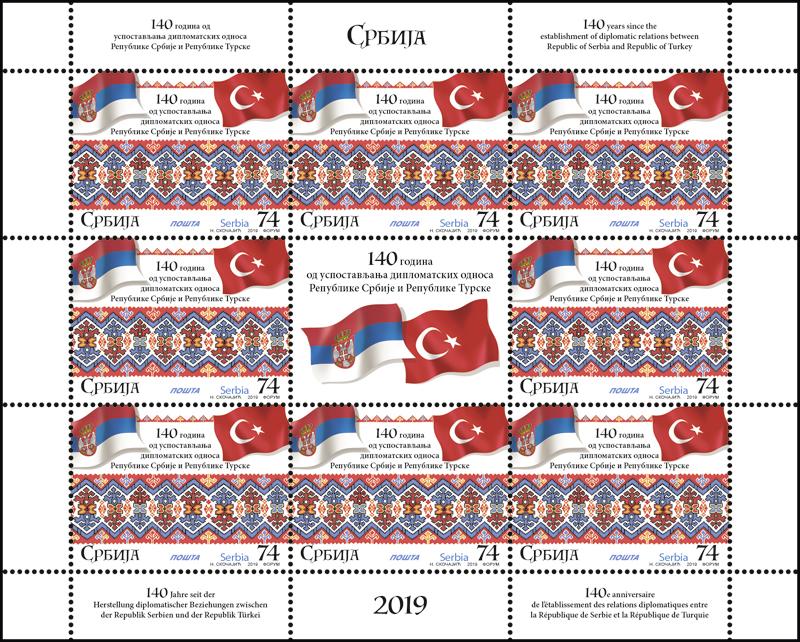


In 1879, the Principality of Serbia and Ottoman Empire formally established diplomatic relations. The first representative of the independent Serbia in Istanbul was diplomat and politician Filip Hristić. By establishing better relations, the Ottoman Empire sent Huseyin Husnu Sermed Efendi to Belgrade on 8 May 1879. Serbia then opened consulates general in the south, in Salonika and Skopje and consulates in Bitola, Pristina and Serres. The Ottoman Empire opened consulates general in Belgrade, Užice, Kragujevac, Niš, Vranje and Kruševac.
Due to the ongoing conflicts in the Balkans, the Kingdom of Serbia, in alliance with Bulgaria, Greece and Montenegro, entered the First Balkan War in 1912, which ended by the London Conference of 1913 culminating in the withdrawal of the Ottoman Empire from the Balkans. After World War I, due to the Greco-Turkish War and unsigned international treaties, the resumption of highest-level diplomatic relations was delayed.
The Republic of Turkey appointed Tahir Lutfi (Tokay) as Turkish Consul to the Polish Embassy in Belgrade from 4 December 1924 to 24 May 1925, then Yusuf Hikmet Bayur was appointed as a delegate to Belgrade on 24 June 1925. Upon the Treaty on Friendship between Turkey and the Kingdom of Serbs, Croats and Slovenes in Ankara on 28 October 1925, diplomatic relations were reestablished. The Republic of Turkey appointed Yusuf Hikmet Bayur as minister on 18 January 1926. The Kingdom of Serbs, Croats and Slovenes designated Tihomir Popović as ambassador in Ankara on 21 July 1926. In other words, diplomatic relations between the Kingdom of Yugoslavia and the Republic of Turkey were constantly improving. The Balkan Pact was formed in 1934, along with Romania and Greece, initiated by King Alexander and Mustafa Kemal Atatürk. The advancement of political relations contributed to the diplomatic missions in 1939 being simultaneously upgraded to the rank of embassies. The first ambassador of Yugoslavia to Turkey was Ilija Šumenković and Turkish ambassador to Belgrade was Tevfik Kamil Koperler.
For the last 80 years, diplomatic relations between the two countries have never been severed despite the occurrence of wars. After the Second World War, at a time when Yugoslavia was isolated by socialist countries, a new Balkan Pact was created in 1952-1954, together with Greece and Turkey. In the new century, relations are once again improving and are becoming better and more successful in the domains of politics and economy, and culture.
Expert collaboration: Embassy of the Republic of Turkey in Belgrade; Dragoš Petrović, MSc in History, Archives of Yugoslavia, Belgrade; Tatijana Karanović, curator, Museum of Ponišavlje, Pirot.
Artistic realization of the issue: MA Nadežda Skočajić, academic graphic artist
Children’s stamp
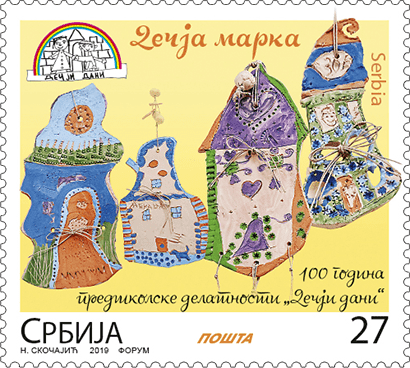

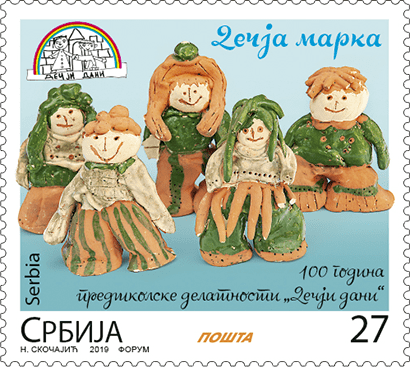
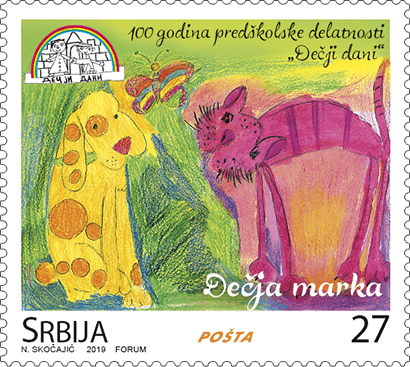
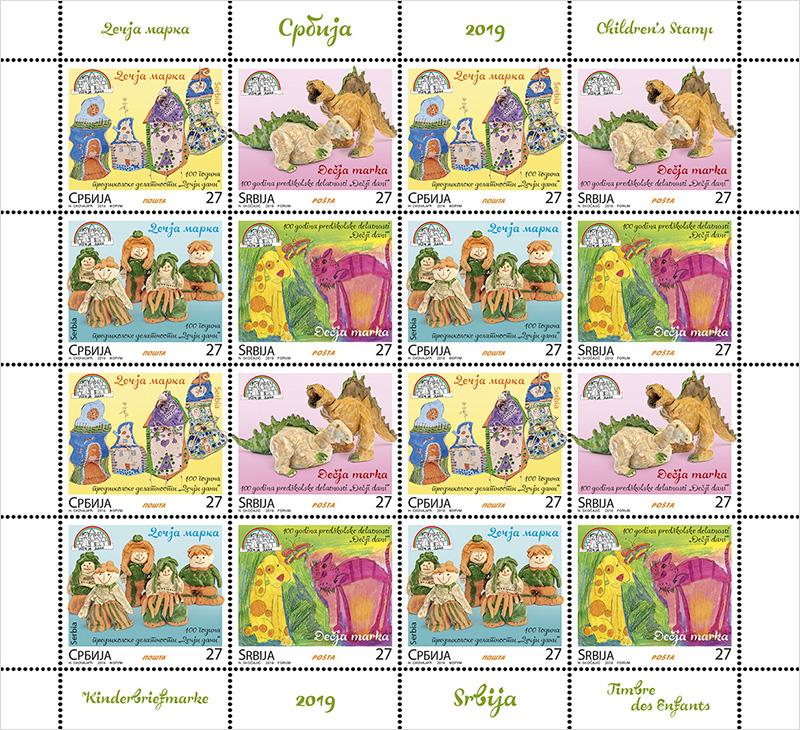



Hundred Years of Preschool Activity “Children’s Days”
In the year of 1919, numerous manifestations dedicated to children and charity work commenced in many cities and towns in the then Kingdom of Serbia, under the title “Children’s Days” and “Children’s Weeks”. The first “Children’s Days” in Belgrade were organised on 28 June 1919. On that occasion, a proclamation was issued which is, even today, the main principle of work with kids in the preschool institution “Children’s Days”:
“It is necessary to proclaim the major principle of the twentieth century
that every child’s life is the most cherished national treasure,
and that it is the duty of the state and of the nation to take great care to protect and
nurture every child,as each human being has the right to live, be healthy and educated.“
Wishing to memorialise this manifestation dedicated to the children of Belgrade, the preschool institution formed in 1992 by merging nursery schools and kindergartens in the Municipality of Stari Grad in Belgrade is given the name of “Children’s Days” as its official name, and the right to continue the tradition of their remembrance.” (Lidija Bubanja – Kalaba, 2004)
The Preschool Institution “Children’s Days” is located in the Belgrade’s Municipality of Stari Grad and comprises eleven nursery schools and kindergartens: Fairy, Little Butterfly, Skadarlija, Linden, Lola, Children’s Club, The Danube Kindergarten, Terazije, Mayflower, Dumbo and Nibbles. Some two thousand children one to six-year old live and grow in them every day. The institution is well-known for its tradition of a variety of forms and programmes of work, which meet the diversified needs of the children and their families.
The very first nursery school in the Municipality of Stari Grad was opened on 16 february 1919 in 32 Brankova Street, in the building rented by the “Society for Children’s Upbringing and Protection” from Mr Slavko Grujić. Today, it bears the name of “The Danube Kindergarten” and, since the opening ceremony on 16 February 1931, it is located at the corner of the Cara Dušana Street and Tadeuša Košćuška Street.
Stamps and envelopes motifs: artwork of the children from the Preschool Institution “Children’s Days”, Belgrade.
Expert collaboration: Preschool Institution “Children’s Days”, Belgrade.
Graphic realization of the stamps: MA Nadežda Skočajić, academic graphic artist.
800 years of Mileševa monastery
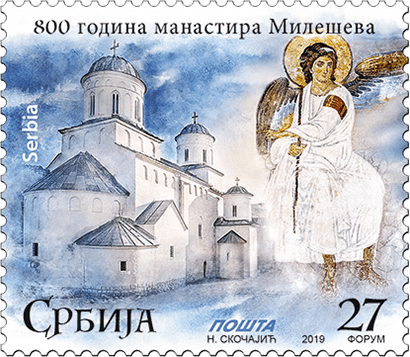




Let your light shine before others, that they may see your good deeds and glorify your Father in heavens (Matthew 5:16)! Many of our honourable ancestors accepted from the heart this wonderful commandment of Christ and fulfilled it. Such men and women left us good works in the fields of art, culture, education as well as various kinds of mercy. Thus, famous works of architecture and literature were created, Serbia itself became a state and the St. Sava Church was organized within the unique Church of the Christ. That is how the monastery Mileševa, the endowment of the Holy King Vladislav of Serbia, was founded.
Mileševa has shone for centuries through its architecture, appearance, painted icons, and constant prayers of the monks who themselves shone through their own personal lives and deeds. The two greatest sources of light in Mileševa remain forever those of the Angel of Resurrection, the so-called White Angel, depicted at the tomb of Christ as he announces to the world the greatest and most important event - the resurrection of Christ, as well as the miraculous tomb of St. Sava, who directly received from the resurrected Christ the power to awaken and revive the Serbs in the most difficult times of their life-weariness. Many have succeeded to attain the much needed peace of the soul in Mileševa and to organize themselves to carry on with their life’s path.
Mileševa has demonstrated many times its extraordinary gift to survive and continue lasting despite having being destroyed and rebuilt on multiple occasions, and our generation was honoured to be the bearer of the celebration of 800 years of Mileševa's existence. By marking this unique jubilee, we actually look deeper into what is most valuable in ourselves, into what most powerfully and beautifully shines through us and gives us the strength to carry on with our lives during these turbulent and complex times. It is our intention and duty to show the light and beauty of the Mileševa monastery to the entire humanity, because it is the humanity to which it belongs, not only us. We wish for the entire world to be illuminated by the light of the White Angel of Mileševa and enlightened by the joy of Christ's Resurrection. In this way, we can provide all with the opportunity to get acquainted with the glorious works of our ancestors, which helps these works fulfil their noble mission around the whole world.
Bishop Atanasije of Mileševa.
Stamp motif: Mileševa monastery and White Angel (Myrrhbearers at Christ's tomb frescoe detail).
Vignette motifs: Mileševa monastery frescoes (1222–1228).
Upper Vignette: Patrons composition – Holy Mother of God brings king Vladislav, carrying the model of his endowment, to the Lord Jesus Christ on the throne.
Vignette on the left: Holy Mother of God (Annunciation frescoe detail).
Central Vignette: Saint Sava.
Vignette on the right: Myrrhbearers at Christ's tomb (detail of frescoe).
Lower Vignette: Asleep guards (Myrrhbearers at Christ's tomb frescoe detail).
Expert collaboration: Serbian Orthodox Church, Eparchy of Mileševa.
Artistic realization of the issue: MA Nadežda Skočajić, academic graphic artist
Joy of Europe




The idea to hold an event every year at the beginning of October, which would be attended by children from all over Europe, was born in the head of Donka Špiček, back in 1968, within the editorial office ”Meetings on Thursdays” at the House of Pioneers in Belgrade. The invitation stated that all segments of the future manifestation will be designed so that children’s play is at the centre of all events.
The first meeting of the children of Europe – The Joy of Europe took place in early October 1969, with the support of the city authorities, President Tito, UNICEF and the United Nations General Assembly. It’s been half a century since then! About 20,000 children and young people from 46 countries visited Belgrade.
The main program unit of the Manifestation since 1998 is the International Art Competition “Joy of Europe”, which invites children and young artists from all over the world to demonstrate with their magnificent palette that children’s visual art has been perceived and recognized from the point of view of in-depth psychology and modern understanding of art as a true creative value. Art works (ages 4 to 18) judged by a jury of experts have traditionally found their place on the appropriate postage stamp “Joy of Europe”.
Such a stamp supports the natural and creative way of life in the most beautiful way possible, stating that this artistic encounter is the essence of international art competitions and exhibitions that follow.
Motif on the stamp: drawing by Anđela Marjanović (14 years, Serbia). Motifs on the vignettes: drawings by Luca Patai (6 years, Hungary), Angela Lin (11 years, Taivan), Natnlie Yan Lok (5 years, China), Tadija Kotorčević (9 years, Serbia), Elena Chiforeanu (10 years, Romania), Luda Alborova (10 years, Russia). Motif on the envelope: drawing by Alona Novika (6 years, Lithuania).
Expert collaboration: Lidija Seničar, Editor of drawing and painting competition, Children’s cultural centre Belgrade. Graphic realization of the issue: MA Jakša Vlahović, academic graphic artist.
100 years of grammar school “Jan Kolar“ with the Students’ home in Bački Petrovac




The Boarding Gymnasium “Jan Kolar” is an education and culture institution of the Slovaks in Vojvodina, Serbia. During its hundred years, many of the school’s 4,665 alumni grew into academicians, doctors of science, physicians and prominent intellectuals in all the walks of life, who contributed with their work to the preservation and prosperity of Slovak national minority both in our country and around the world.
The Gymnasium was founded on 1 October 1919 as the Slovak Real Gymnasium and for decades it was the only secondary school teaching in Slovak in the world outside Czechoslovakia. It was the result of the high national conscience of the Slovaks who lived in this area, never cloistered into the small confine of nationality and constantly engaged in the relations of cohesion with other nationalities.
Since 1923, the Gymnasium has its own, custom-designed building, which acquired its today’s appearance in 1927. This imposing facility was built from the charity contributions of the Slovaks all over the world and with the significant financial help of the Czechoslovakian Republic.
After the Second World War, in the school year 1947/1948, a Teacher College was founded within the Gymnasium. During its twenty years of work, the School produced 216 teachers who became the torchbearers of cultural and educational life of the Slovaks in the entire Province of Vojvodina.
To provide educational opportunities to students from all parts of Vojvodina, the state-of-the-art boarding space was created within the Gymnasium in 1997, with 82 beds. Owing to this, the Gymnasium nowadays educates students from 26 cities, towns and villages.
The tradition of extracurricular activities of the school’s students is rich, most notably the literary section Sladkovič that was founded in 1925, from which sprang a Pleiad of authors writing in the Slovak language. The vibrant school’s sections – art, drama, folk dance, science, humanities – are integral parts of the Gymnasium’s work, making the school outgrow the frame of a typical educational institution, and for decades, it has been the driving force of the life of the Slovaks in Serbia.
For its outstanding contribution, the Gymnasium received many awards both in Serbia and the Slovak Republic.
Expert collaboration: Anna Medved, headmistress of the Grammar school “Jan Kolar“ with the Students’ home in Bački Petrovac.
Artistic realization of the issue: MA Anamari Banjac, academic painter.
Stamp day – 150 years of postal card

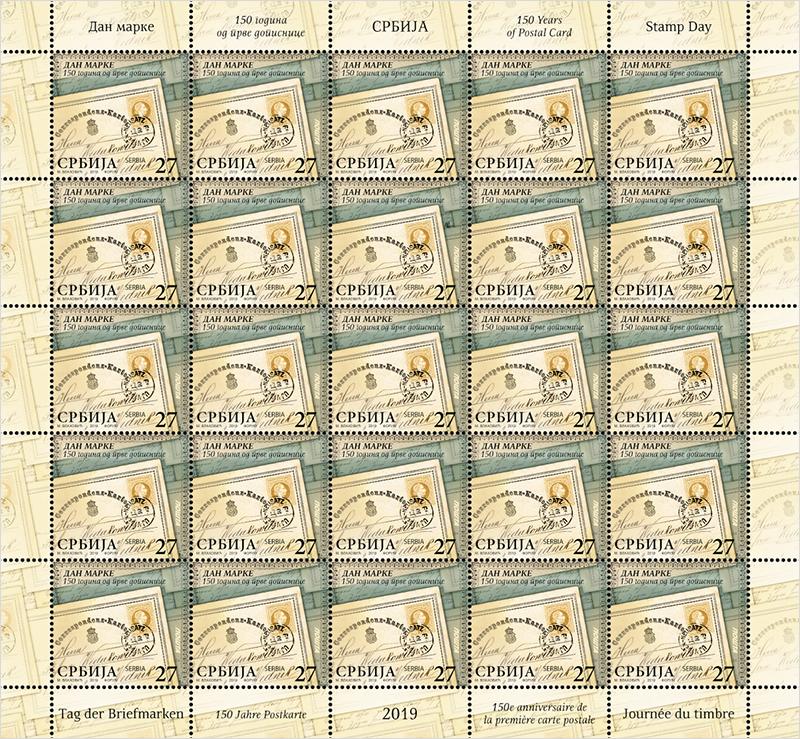


Postal card is open stationery issued by the governmental postal authority, weighting up to 20 g. rectangular shaped in defined format, made of cardboard or strong paper, with imprinted stamp or an indicium of prepaid postal service at the rate lower than the one required for the letter. The world’s first official postal card was released on 1 October 1869 for inland postal traffic within the Austro-Hungarian Monarchy.
Professor of economics Emanuel Herrmann, in January of 1869 in Viennese press proposes the new means of postal communication. He suggested the 2 kr. price for short messages being carried on standard forms lower even than that for a local letter, and by printing remark that the post denies any responsibility for the content of the message, he solved the main problem. New mean of communication was given the name Correspondenz-Karte.
Prepared thoroughly, postal cards were printed on yellowish paper 122 x 85 mm in size in huge quantities and timely distributed to all countries of the Dual Monarchy, with imprinted stamp of 2 kr. for unlimited traffic. Difference existed only with the coats of arms, Austria and Hungarian. The employees were strictly ordered to treat the postal cards like they would letters, to accept and process them without delay, deliver promptly, while they were also subject to registered handling. Knowing that the mail was delivered twice and in bigger cities even several times a day, postal cards made possible to arrange a meeting or business the same day for the low price. The success was immense! According to data, only on first day some 10.000 were sold, during the first month 1,4 million and by the end of year some 3 million pieces! The following year several European countries introduced this novelty, and Serbia did it in 1873.
In today’s Serbia, in Vojvodina, all three varieties of the first postcard circulated: the Austrian, distributed to Military Border, and Hungarian on both languages – German and Hungarian. The addressing language was irrelevant, so the Serbs as other nationalities wholeheartedly accepted postal cards, noticing that renouncement of responsibility for the contents allows them cheap communication in own language.
Presented postal card is probably the oldest preserved from our area, written on 13th and posted on Friday, October 15th 1869, from Novi Sad to Vrdnik, last post Irig, received the same date.
Expert collaboration: Eng. Ivan Tangl, Novi Sad.
Graphic realization of the issue: MA Marija Vlahović, academic graphic artist.
Christmas






Christmas is one of the most important and one of the most joyous Christian holidays, that is celebrated both by the Orthodox and Catholic believers. The difference is only in the date of the celebration; the Orthodox celebrate it on January 7th, and the Catholic on December 25th, but its message remains the same – the message of peace and love.
We celebrate Christmas for three days. It is primarily family holiday, and there are numerous traditions and customs regarding Christmas. On the day before Christmas and Christmas Eve, the yule log is being brought into house, cresset lit and hay with hidden candies, prunes, walnuts, sugar and coins, spread all over the house. The hay is a symbol of the manger in which Christ was born. The yule log represents longevity and substance of Christianity, as well as of the warmth of the love Christ brought to us when he was born and arrived to the Earth. On the very day of the Christmas, early in the morning the church bells of all Orthodox temples are ringing, announcing the nativity of Christ. People go to church to attend Christmas liturgy and they all greet each other by “Christ has been born” and “Indeed he has”.
Expert collaboration: The Museum of the Serbian Orthodox Church in Belgrade.
Artistic realization of the issue: Miroslav Nikolić.
75 Years of ”Filmske novosti” newsreel




Today, ”Filmske novosti” is a film archive managed by the Ministry of Culture and Information of the Republic of Serbia, within the Cultural Heritage Protection Sector.
Back in 1944, following the liberation of Belgrade on 20 October 1944, Josip Broz Tito, the President of Yugoslavia, founded ”Filmske novosti” as the first film production company in the new Yugoslavia, entrusted with production of newsreels and documentaries.
From 1944 to 1989, 15.5 million meters of film tape were recorded, depicting political, economic and cultural events in the former Yugoslav area. The recordings of all the conferences of the Non-Aligned Movement, meetings and visits of foreign statesmen to Tito (Kennedy, Queen Elizabeth II, Haile Selassie, Nasser, Sukarno...), theatre premiers, film festivals, visits of famous artists (Orson Welles, Alfred Hitchcock, Elizabeth Taylor, Laurence Olivier, Richard Burton, Sam Peckinpah, Vivien Lee, and many others), the liberation wars and life in Algeria, Mali, Mozambique and Tanzania, make just a part of what ”Filmske novosti” safeguards today, and in the creation of which Mira Trailović and Puriša Đorđević as editors, Rade Marković as a voice actor, Dragan Mitrović and Stevan Labudović as cameramen and Đorđe Kadijević, Goran Marković, Dejan Karaklajić, Danilo Bećković, Miroslav Lazanski, Petar Ristovski as directors, have contributed by their long-standing work to ”Filmske novosti” journals, enriching their information purpose with artistic significance.
During these seven and a half decades, 2,813 newsreels were recorded and presented in all the cinemas of the former Yugoslavia before feature and other films, and the production of documentaries still continues.
Expert colaboration: Vladimir Tomčić, Director of ”Filmske novosti” newsreel.
Graphic processing: Anamari Banjac, academic painter.
Art


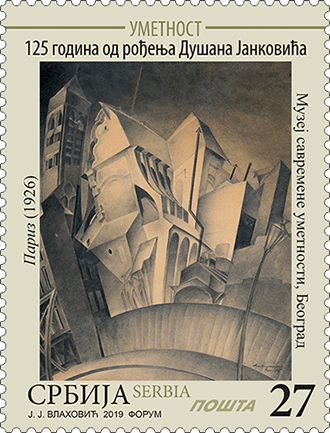




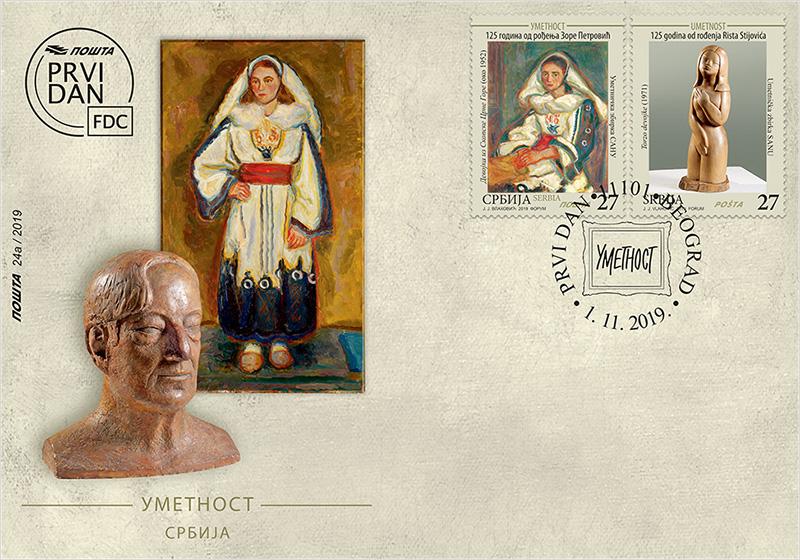
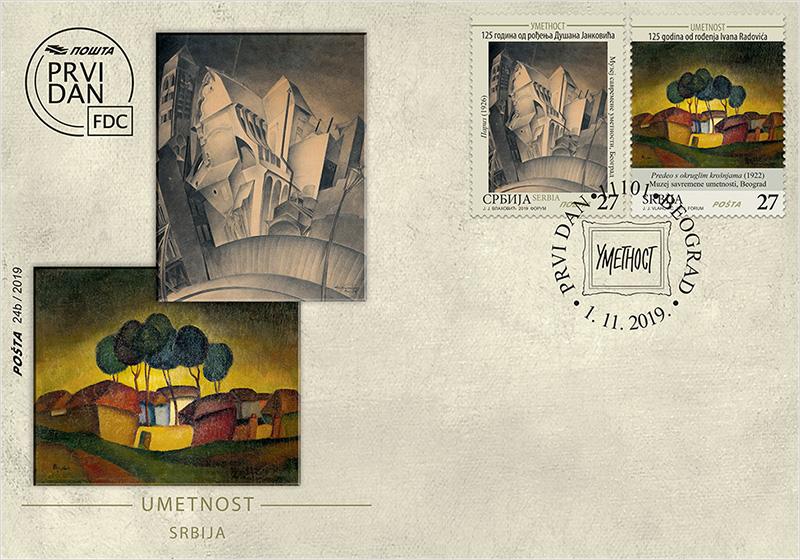


125 years since the birth of Zora Petrović
(Dobrica, 1894 – Belgrade, 1962)
Zora Petrović began her education in painting at the Arts and Crafts School in Belgrade (in 1912-1914) with professors Milan Milovanović, Djordje Jovanović and Marko Murat. Between 1915 and 1919, she attended Art High School in Budapest under the guidance of professor Lajos Deák-Ébner. Together with Ivan Radović, she spent the summer of 1918 at the Artists’ Colony in Nagybánya supervised by professor István Réti. Petrović then spent two months at André Lhote’s art school during her time in Paris from 1925 to 1926 and became a professor at the Academy of Fine Arts in Belgrade in 1952. She was a member of the Lada, Oblik (Shape) and Samostalni (Independent) art associations. Along with taking part in numerous group exhibitions, she has held solo exhibitions in Belgrade (in 1927, 1930, 1933/34, 1937, 1952, 1955, 1957, 1958, 1959, 1960), in Sarajevo in 1951, Zrenjanin in 1962 and in Kikinda in 1962. Following her death, a retrospective of works by Petrović was exhibited in Belgrade in 1978 and another exhibition of her work organized at the Serbian Academy of Science & Art (SANU) gallery in 1995. She was the recipient of the City of Belgrade’s October Award in 1956. She was a correspondent member of SANU from 1961.
Motif on the stamp: Girl from Skopska Crna Gora (about 1952), motif on the envelope: Peasant girl.
125 years since the birth of Risto Stijović
(Podgorica, 1894 – Titograd, 1974)
Risto Stijović, a sculptor, moved to Belgrade in 1912 in order to attend the School of Commerce but very quickly enrolled in Royal Art School in Belgrade in the class of professor Djordje Jovanović. During his studies he visited Ivan Meštrović’s atelier in Belgrade. He joined the Serbian Army in the First World War. After the war, he attended the Marseille School of Art for a year under the guidance of professor M. E. Aldeber. He moved to Paris in 1917 where he attends the École des Beaux-Arts in the class of professor Jean Antoine Injalbert. Stijović participated in a large number of group exhibitions. He also exhibited his work individually in Belgrade (in 1928, 1937, 1951, 1959, 1964, and 1969), Venice in 1957, Čačak in 1957 and in Titograd (renamed Podgorica where he was born) in 1959. He was the recipient of numerous awards and acknowledgements for his sculptures. Prior to becoming a full member of the Serbian Academy of Science & Art (SANU) in 1965, he was a a correspondent member from 1963.
Motif on the stamp: Torso of a girl (1971), motif on the envelope: Aleksandar Deroko (1973).
Expert collaboration: Serbian Academy of Sciences and Arts.
125 years since the birth of Dušan Janković
(Niš, 1894 – Belgrade, 1950)
Dušan Janković began studying architecture at the Technical Faculty in Belgrade. His studies were interrupted by the outbreak of the First World War and he crossed into Albania after joining the Serbian Army in 1915. He ended up in France thanks to the Serbian army student detachment in 1916 and continued to study architecture in Paris in 1917-1918. On completing his studies, Janković had stints with leading Parisian publishing houses such as Flammarion, Larousse, Le Monde Moderne, and Kharma and became an associate for the renowned Manufacture Nationale de Sèvres (later renamed Sèvres – Cité de la Céramique), the French manufacturer of fine porcelain and ceramics, and French porcelain producer Bloch et Fils. He designed a villa in the affluent Paris suburb of Saint-Clod, along with its entire interior design and furniture, and decorated one of the rooms at the Moulin Rouge.
In parallel with this artistic production, Janković participated in international exhibitions in his home country and with Yugoslavian artists abroad. He returned to Belgrade in 1935. He was an artistic instructor at the then state printing company Državna štamparija, a technical director at the Novo pokoljenje (New Generation) publishing house, and he also worked as a part-time professor at the Academy of Applied Arts in Belgrade. He died in 1950 when he held the position of art editor at the Jugoslavija magazine.
Motif on the stamp and envelope: Paris (1926).
125 years since the birth of Ivan Radović
(Vršac, 1894 – Belgrade, 1973)
Ivan Radović is a well-known Serbian modern artist who studied painting at the Hungarian Academy of Fine Arts in Budapest. In 1929, he was the winner of the championship of Yugoslavia in tennis. He played for the national team at the Davis Cup. He has had solo exhibitions in Belgrade (in 1925, 1928, 1929, 1932, 1952, 1960, 1966, 1971, 1984 – drawings) and a solo exhibition in Novi Sad in 1966. Radović regularly showcased his work in group exhibitions in the country and acted as a state representative of Yugoslavia abroad. He was involved with educational work (the Belgrade Art School). He has received numerous awards and acknowledgments for his work and was a member of the Serbian Academy of Sciences and Arts (SANU).
In his work, Radović went through various stages of artistic styles of expression: Cubo-Constructivism, Neoclassicism, Abstraction, Naїve Art, Intimism, and Poetic Realism. Along with Naїve Art as an attitude and as a new subject of painting, he also discovered and explored the field of pure art, with an emotional and personal interpretation of art, the authentic joy of life, and pointed to the orientation towards the inner world. The Vojvodina countryside is a recurrent theme in Radović’s work, with a distinctive atmosphere of optimism, humanity and sensuality, and a spontaneous, fateful love for his place of birth.
Motif on the stamp and envelope: Landscape with round tree tops (1922).
Expert collaboration: Museum of Contemporary Art, Belgrade.
150 years since the birth of Henry Matisse
(Le Cateau–Cambrésis, 1869 – Nice, 1954)
As one of the pioneers of experimental art, Henri Matisse is one of the greatest colorists and influential painters of the twentieth century. With the use of vivid colors and color not used descriptively in his works, he laid down the foundations for the Fauvism art movement at the turn of the century. In this respect, he heavily influenced artists of Cubism, Expressionism, Surrealism as well as those of the Pop Art movement in the United States. What sets him apart from the rest in the history of art is that he simultaneously experimented with entirely different styles of painting. Matisse’s career path in law took a turn when he enrolled in the Académie Julian in 1891. A year later, he transferred to the Ecole des Beaux-Arts (the National School of Fine Arts) and became a pupil of the Symbolist artist, Gustave Moreau. Besides Moreau, he was at the time also influenced by Edgar Degas, Henri de Toulouse-Lautrec, Pierre-Auguste Renoir, Paul Cézanne and Japanese graphics. During his studies, in the Louvre Museum he copied the works of Old Masters such as Nicolas Poussin, Raphael, Philippe de Champaigne, Jean-Baptiste-Siméon Chardin, Jacob van Ruisdael, and Jan Davidsz de Heem. For this reason, Matisse’s early works are set in restrained color palettes, whereas his landscape paintings from Brittany already exhibit bright colors and characteristic freedom in his surface treatment. Around 1905, Matisse formed his own personal expression in art and with it, along with a handful of his followers, a new movement in modern art – Fauvism. Matisse’s style of painting is diverse, probing and experimental, but his artistic expression is marked by eliminating details and simplifying the lines and colors, and his painting is a colorfully orchestrated surface composed in a way a kilim (a flat tapestry-woven carpet or rug) is made. His works of art do not render forms as they appear in real life. With the help of “color signs”, Matisse searched for the general essence of a being, the character of a drawn face, which is not determined by proportions, but rather by a certain inner light – that of the painter’s energy. His works are simplified to the extreme, butterfly-like, and contain simple forms; they make an enormous impact through the use of color, because it is an overriding element in his work. The subjects painted most frequently by the artist are landscapes and still lifes but he also captured the motifs of the interior. He is also a highly regarded as a sculptor (and for his nude sculptures in particular). Matisse’s art ranges between the kilim and the window, the two most common motifs in his paintings. The search for new aesthetic solutions through repetition of motifs is a principle he adhered to throughout his life.
His most famous works include “La Desserte”, painted in 1897; “Carmelina”, 1903; “Luxury, Serenity and Pleasure”, 1904-1905; “Open Window” and “Woman with a Hat”, 1905; “The Joy of Life”, 1905-1906; “Self-Portrait in a Striped T-shirt”, 1906; “Blue Nude”, 1907; “Le Lux II”, 1907-1908; “The Dessert: Harmony in Red”, 1908-1909; “The Red Studio” and “The Goldfish”, both painted in 1911, and “The Piano Lesson”, 1916-1917.
Motif on the stamp: By the window (1918), Motif on the envelope: Head of a girl (1939).
Expert collaboration: National Museum in Belgrade.
Graphic realisation of the issue: MA Jakša Vlahović, Academic Graphic Artist.
Famous persons of Serbia


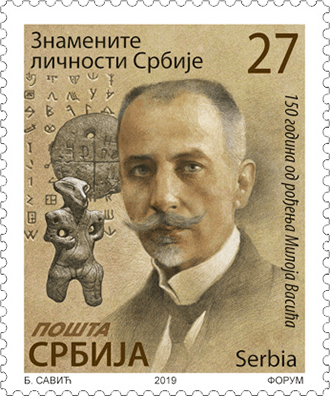




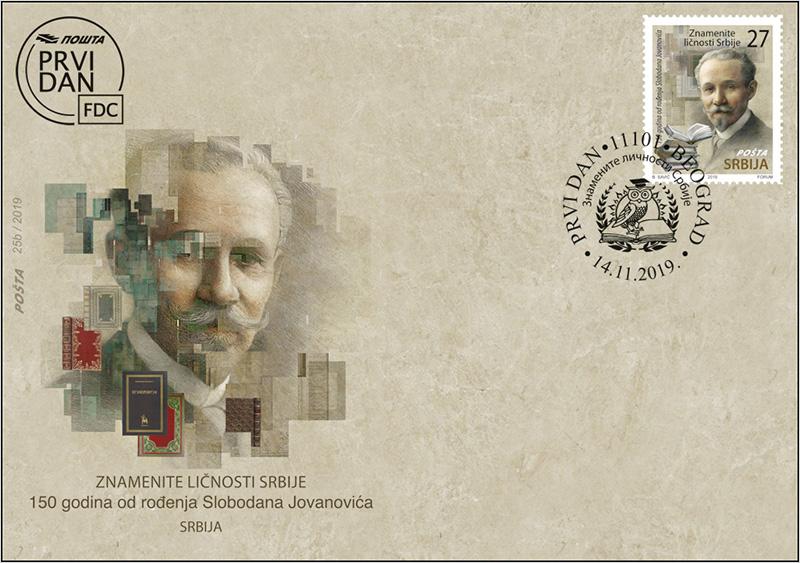


125 Years Since the Birth of Aleksandar Deroko
Aleksandar Deroko (1894 – 1988) was a Serbian architect, professor at the Department of Architecture at the Faculty of Architecture at the University of Belgrade. He is the author of numerous books in the field of architecture, but also other areas. He became a member of the Serbian Academy of Sciences and Arts in 1956.
Prior to the war, Deroko was a versatile athlete, and he also worked in modeling. He designed and built one of the first gliders in Serbia. The outbreak of World War I found him studying. He participated in the war as one of the 1300 Corporals, when he became one of the first Serbian war pilots on the Salonika Front.
At the end of the war, he continued studying architecture and art in Rome, Prague (he also spent two semesters at the Faculty of Architecture and Construction of the Czech Technical University in Prague), Brno and Belgrade, where he graduated in 1926. As a scholarship holder of the French government, he went to Paris where he socialized with Picasso, Šumanović, Le Corbusier, Rastko Petrović and others.
He won the competition for the project of the Temple of St. Sava in 1926, and later he designed the project with architect Bogdan Nestorović and worked on its construction from 1939 – 1941. With Peter Anagnosti he designed the Theological Boarding School in Belgrade, the so-called Bogoslovija, as well as the Eparchial lodge in Niš; he is the author of the Monument to the Heroes of Kosovo in Kosovo Field, the lodge of the Žiča Monastery, the Temple of the Transfiguration of Christ in New Sarajevo, the Chapel of the Vidovdan Heroes, where Gavrilo Princip was buried and many churches.
During World War II Deroko was imprisoned in a detention camp in Banjica. On several occasions (1954, 1956 and 1965), he traveled to the Holy Mount Athos, on whose architecture and life he left valuable data. He is the author of the books Holy Mount Athos, People’s Construction, Medieval Cities in Serbia, Macedonia and Montenegro, Monumental and Decorative Architecture in Medieval Serbia, Roman Monuments in Đerdap, Architecture of the Old Age, Medieval Cities on the Danube, Athos, And Then an Airplane Flew Above Belgrade, Mischievs Around Kalimegdan.
He is the holder of the Albanian Commemorative Medal, the winner of the Seventh of July Award, the Order of the Red Banner of Labour, the Order of the Republic with Gold Wreath, the French Médaille du mérite and the October Award of Belgrade.
Expert collaboration: Serbian Academy of Sciences and Arts.
Artistic realization of the issue: Boban Savić, MA, academic painter.
150 Years Since the Birth of Slobodan Jovanović
Slobodan Jovanović (Novi Sad, Austro-Hungarian Empire, 1869 – London, United Kingdom, 1958) was a Serbian scientist and university professor, jurist, historian and a man of letters, President of the Serbian Royal Academy, Chancellor of the University of Belgrade, Dean of the Faculty of Law, President of the Serbian Cultural Club. Having completed a grammar school in Belgrade in 1886, he studied at the faculties of law in Munich, Zurich and Geneva and at the Free School of Political Sciences in Paris in 1890/1891. For a time he was a state grantee of the Kingdom of Serbia. He was the Professor at the Faculty of Law from 1897 till 1940. Upon retirement, he continued to work as a part-time Professor. He was the President of the Serbian Royal Academy from 1928 till 1930.He was one of the founders of Serbian Literary Gazette in 1901. He was elected corresponding member of Serbian Royal Academy on 4 February 1905, and in 1908 he became its full-time member. He was president of Serbian Royal Academy from 1928 untill 1930.During the Balkan Wars and the World War I, Slobodan Jovanović was the chief of the Press Bureau of the Supreme Command’s Intelligence Department. After the retreat over Albania, he spent some time in Thessaloniki and Corfu. At the Peace Conference in Paris in 1919, he was the head of the legal section of delegation of the Kingdom of Serbs, Croats and Slovenes. He wrote papers in a variety of fields – theories of state and law, consitutional law, political philosophy, general history and Serbian history of XIX and XX centuries, sociology, studying of literary works, literary and theatrical criticism. His studies were written in his famous Belgrade style. His collected works were published in 1930s in several volumes.After the Yugoslav coup d’état of 27 March 1941, he accepted the invitation to join the multi-party government as the second Vice-President of the Ministerial Council (Government). He died in London in 1958. In early 1990s, his collected works were re-published in Belgrade. He was rehabilitated in 2007, and solemnly buried in Belgrade in 2011.
Expert collaboration: Serbian Academy of Sciences and Arts. Artistic realization of the issue: MA Boban Savić, academic painter.
150 Years Since the Birth of Miloje Vasić
Miloje M. Vasić, an archeologist and university professor was born in Veliko Gradište on 16 September, 1869. He completed classical philology and history at the Belgrade Great School in 1892. For a certain period of time he worked as a teacher at the Grammar School in Veliko Gradište and Negotin. In 1895 he was appointed assistant guardian at the National Museum in Belgrade. With the help of Mihajlo Valtrović, he obtained a scholarship for the study of archeology in Berlin (1896 – 1898) and then moved to Munich with Professor A. Furtvengler (1898 – 1899) and defended his dissertation Torch in the Cult and Art of the Greeks (Die Fackel in Kultus und Kunst der Griechen). He was the director of the National Museum from 1906 to 1914. He became an associate professor in 1920, and from 1922 he was a full time professor until his retirement in 1939. He chaired an archeological seminar (1903 – 1939) and was editor of Starinar from 1922 – 1939. After the World War II he re-activated himself as a full time professor (1947 – 1955) and participated in establishing the Archeological Institute. Since 1949 he was a correspondent, and since 1952 a full member of the Serbian Academy of Sciences and Arts.
He published a number of treatises and articles in the fields of prehistory, classical and medieval archeology, numismatics, art history, religious history and ethnology. His scientific work began in 1894 with the publication of works on Pincum (Veliko Gradište) and Viminacium, Roman cities on the soil of present-day Serbia. In his scientific work, he rejected earlier archeological methods, based on the collection of materials and their descriptions, and gave expert analyses, placing the findings in a broader cultural and historical context. From 1899 to 1911 he excavated at several sites in Serbia. The results of the research, published in the studies Contributions to Trojan Problems Solving (1906), Žuto Brdo (1907) and Gradac (1911), are significant because they lay the foundations of archeological science in Serbia.
Since 1911 he began systematic research in Vinča but discontinued it due to the First World War. After the end of the war it was not possible to continue excavations due to the lack of money, so he began studying medieval architecture and art. On these researches he published the works Architecture and Sculpture in Dalmatia from the IX to the 15th Century (1922) and Žiča and Lazarica (1928). He continued with systematic excavations in Vinča (1929 – 1934), and the result of this research was the work Prehistoric Vinča I – IV (1932 – 1936). He died in Belgrade on 4 November, 1956.
Expert collaboration: National Museum Veliko Gradište.
Artistic realization of the issue: Boban Savić, MA, academic painter.
75 Years of the Weekly Newspaper JEDINSTVO




Jedinstvo is the oldest information and cultural institution in Kosovo and Metohija.
During the struggle for the liberation of Yugoslavia, on December 25, 1944, a five-member editorial board published the first issue of the newspaper in Serbian language, entitled Jedinstvo.
For the past 75 years, Jedinstvo had been and continues to be an information and cultural centre that brings together authors creating in Serbian language – Serbs, Montenegrins, Muslims and Goranci.
In the beginning, Jedinstvo was a monthly newspaper, then in 1946 it became a weekly, and starting 1969 it was being published twice a week. It had been a daily paper from 1977 until the end of NATO aggression against FR Yugoslavia in 1999. Throughout this period, Jedinstvo was printed in Pristina.
Journalists and media workers of Jedinstvo paper were expelled from their editorial offices after the arrival of international forces and their property was usurped and stolen. Nevertheless, the newspaper continued its life in northern Kosovo and Metohija, where its offices are to this day and where it is published once a week.
In addition to the newspaper, the editorial board started a literature, arts and culture magazine in 1960, titled Stremljenja, which is still being published today. During the same year, publishing activities were initiated and Jedinstvo has published more than a thousand books to date, many of which are award-winning. The social affairs, science and culture magazine – Obeležja, was launched in 1971 and was being published until NATO aggression against the FRY.
Within Jedinstvo, in the 80’s and 90’s of the last century, there was also a monthly newspaper for the elementary school students, Đurđevak, a village newspaper, Uranak, as well as a Journal for the workers in educational, cultural and scientific fields. Jedinstvo also published Auto-moto review, as well as corporate papers for industrial collectives.
Since 1970, Jedinstvo has been the organizer of the largest cultural manifestation in the Province –Poetry Meetings Lazar Vučković, which is, to this day, a significant cultural event. With the Lazar Vučković Prize for poetry, this year the manifestation will be held for the 15th time.
Jedinstvo is, among other numerous recognitions, the recipient of two Orders of the Brotherhood and Unity of Josip Broz Tito (1965, 1970), the Order of the State Union of Serbia and Montenegro (2004), the Vuk Award (1975, 1989), the November Prize of the City of Pristina (1994, 1997), Grand Charters of the Association of Journalists of Serbia (1995, 2004), Grand Medal of the Association of Writers of Serbia.
Expert collaboration: Rada Komazec, editor-in-chief, Jedinstvo.
Graphic realization of the issue: MA Marija Vlahović, academic graphic artist.
Slava – Celebration of Family Saint Patron’s Day




Slava, celebration of family saint patron’s day, represents a ritual dedicated to a certain Christian saint who is believed to be a family’s patron saint and the giver of welfare. Celebrating a patron saint is practiced by a majority of Orthodox Christian families on the territory of Serbia as a significant family holiday with the participation of individual families and their guests – members of wider kinship, neighbours, friends. The Serbs experience patron saint’s day as a way of expressing national identity and they are the bearers of this tradition, but the celebration of a family patron saint are also practiced by Orthodox Christian families of some other ethnic communities in Serbia.
In the home of a family, on patron saint’s day a candle is lit during the performing of the ritual, The Lord’s Prayer is said and a ritual cutting of the Slava cake is performed – which necessarily has an impressed symbol IС ХС НI KA – in a way that it is overflowed with wine, cut in the shape of the cross, then it is turned, lifted up and broken in four parts. During the ritual the words of gratitude and prayers for welfare are said to the patron saint.Ritual cutting of the cake is performed by all the members of the family at their home, but on the other hand, it is a common practice to take the Slava cake to church, and in some cases a family welcomes their priest at home to cut the cake. An important part of the celebration of a patron saint is a feast which gathers together the whole family and their cousins and friends.
Patron saint’s day is a vital element of our intangible cultural heritage and in 2014 it was entered on UNESCO Representative list of Intangible cultural heritage of the humankind.St. Sava – Savindan, dedicated to the first Serbian Archbishop and Serbian educator, is celebrated on January 27th. It is one of the largest family holidays among Serbs. It has been proclaimed a school Slava, but is also celebrated by many artisans.
Motif on stamp: St. Sava, (icon, 2016, art-work of sorority of St. Nicholas monastery – Končul) from the St. Sava temple on the Vračar plateau. Motif on FDC: candlestick, letter–mold for Slava cake and cresset (exhibits of Ethnographic Museum in Belgrade, photographs by author Ivana Masniković Antić MA), icon of St. Sava.
Expert collaboration: Ethnographic Museum in Belgrade.
Graphic realization of the issue: Nadežda Skočajić, MA graphic artist.
Serbia – European Volleyball champion

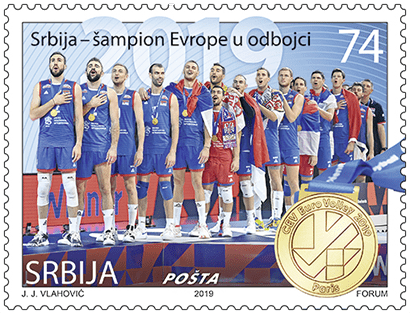





Serbian volleyball national teams managed to repeat their success achieved in 2011 again in 2019 and win gold medals on the XXXI EC, played in Ankara and Paris. Serbian women volleyball seniors and men volleyball seniors have won their third European champion’s titles this year. Women senior volleyball players also won their titles in 2011 and 2017, whereas men senior volleyball players won their titles in 2001 and 2011. Before Serbia, double European champions were only the Soviet Union (USSR) and Czechoslovakia (CSFR), with Russia being the only country to have achieved the same success as Serbia.
Serbian women’s volleyball national team is the double European champion in two consecutive championships. In Ankara 2019 Serbia repeated its success from Baku 2017 and won its third European champion title. Serbia is also the current champion of the WC 2018 played in Yokohama and the current Olympic runner-up from the OG 2016 played in Rio de Janeiro.
Serbian national team players who played in Ankara: Bjanka Buša, Katarina Lazović, Mina Popović, Slađana Mirković, Brankica Mihajlović, Maja Ognjenović, Stefana Veljković, Teodora Pušić, Ana Bjelica, Maja Aleksić, Silvija Popović, Tijana Bošković, Bojana Milenković and Jelena Blagojević. Staff members were Zoran Terzić, Branko Kovačević, Marko Gršić, Bojan Perović, Siniša Mladenović, Vladimir Banković, dr Dejan Aleksandrić and Dimitrije Pušić.
Tijana Bošković, Serbian opposite hitter, was awarded as the best player (MVP) and the best opposite hitter of the Championship, Maja Ognjenović, the captain and the setter of the Serbian team, was the best setter, and Brankica Mihajlović, Serbian receiver, was the best receiver of the EC 2019.
Tijana Bošković, Serbian opposite hitter, was awarded as the best European woman volleyball player in 2019 according to the selection of the CEV (European Volleyball Confederation). This is the third consecutive best player award for Ms. Bošković in Europe.
Serbian volleyball national teams managed to repeat their success achieved in 2011 again in 2019 and win gold medals on the XXXI EC, played in Ankara and Paris. Serbian women volleyball seniors and men volleyball seniors have won their third European champion’s titles this year. Women senior volleyball players also won their titles in 2011 and 2017, whereas men senior volleyball players won their titles in 2001 and 2011. Before Serbia, double European champions were only the Soviet Union (USSR) and Czechoslovakia (CSFR), with Russia being the only country to have achieved the same success as Serbia.
Serbian men’s volleyball national team won the gold medal on the XXXI EC 2019 in Paris, thus becoming the triple European champion. Serbia also won titles in 2001 in Ostrava and in 2011 in Vienna.
Serbian national team in Paris: Aleksandar Okolić, Uroš Kovačević, Nemanja Petrić, Lazar Ćirović, Nikola Peković, Petar Krsmanović, Marko Ivović, Nikola Jovović, Aleksandar Atanasijević, Dražen Luburić, Neven Majstorović, Marko Podraščanin, Srećko Lisinac and Vuk Todorović. Staff members were Slobodan Kovač, Ljubiša Ristić, Igor Žakić, Dr Ljuban Martinović, Dejan Vuković, Ivan Popović, Radovan Vemić, Mirko Radisavljević, Radivoje Radaković, Zdravko Aničić and Slobodan Boškan.
Uroš Kovačević, Serbian receiver, was awarded as the best player (MVP) and the best receiver of the European Championship, Aleksandar Atanasijević, Serbian opposite hitter, was the best opposite hitter, and Srećko Lisinac, Serbian blocker, was the best blocker of the EP 2019. Uroš Kovačević, Serbian receiver, was awarded as the best European player in 2019 according to the selection of the European Volleyball Confederation (CEV), whereas Slobodan Kovač, the first coach of the Serbian men’s volleyball seniors, was awarded as the best coach in Europe in 2019.
Expert collaboration: Volleyball Federation of Serbia.
Graphic realisation of the issue: MA Jakša Vlahović, Academic Graphic Artist.